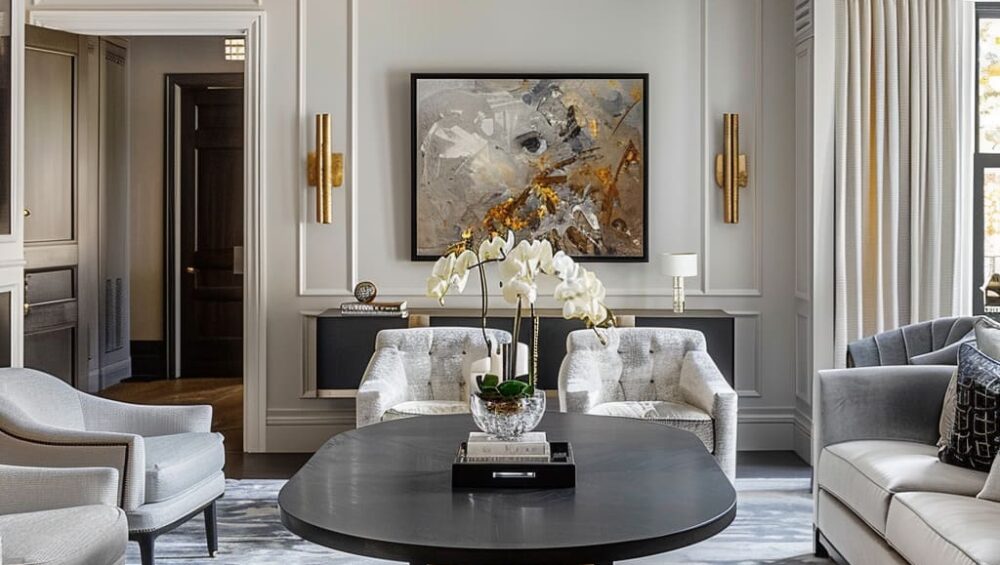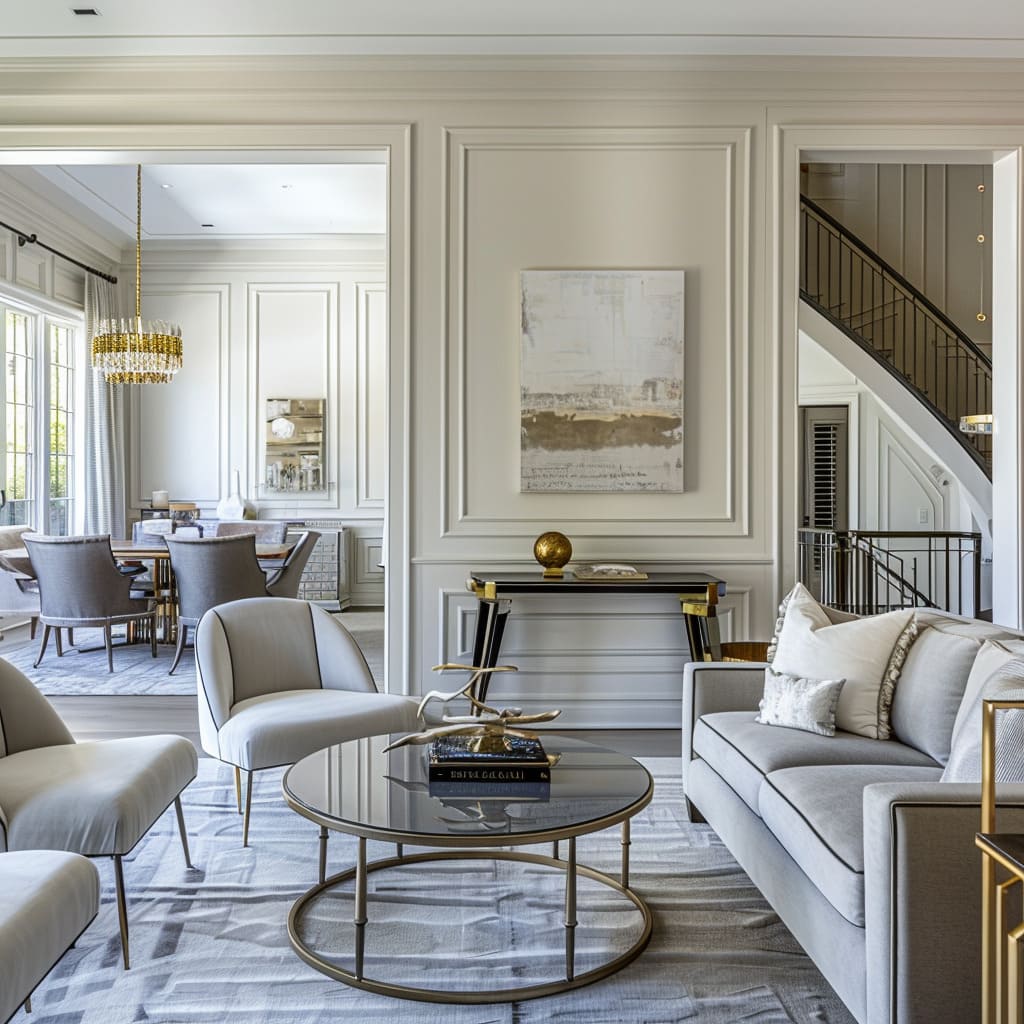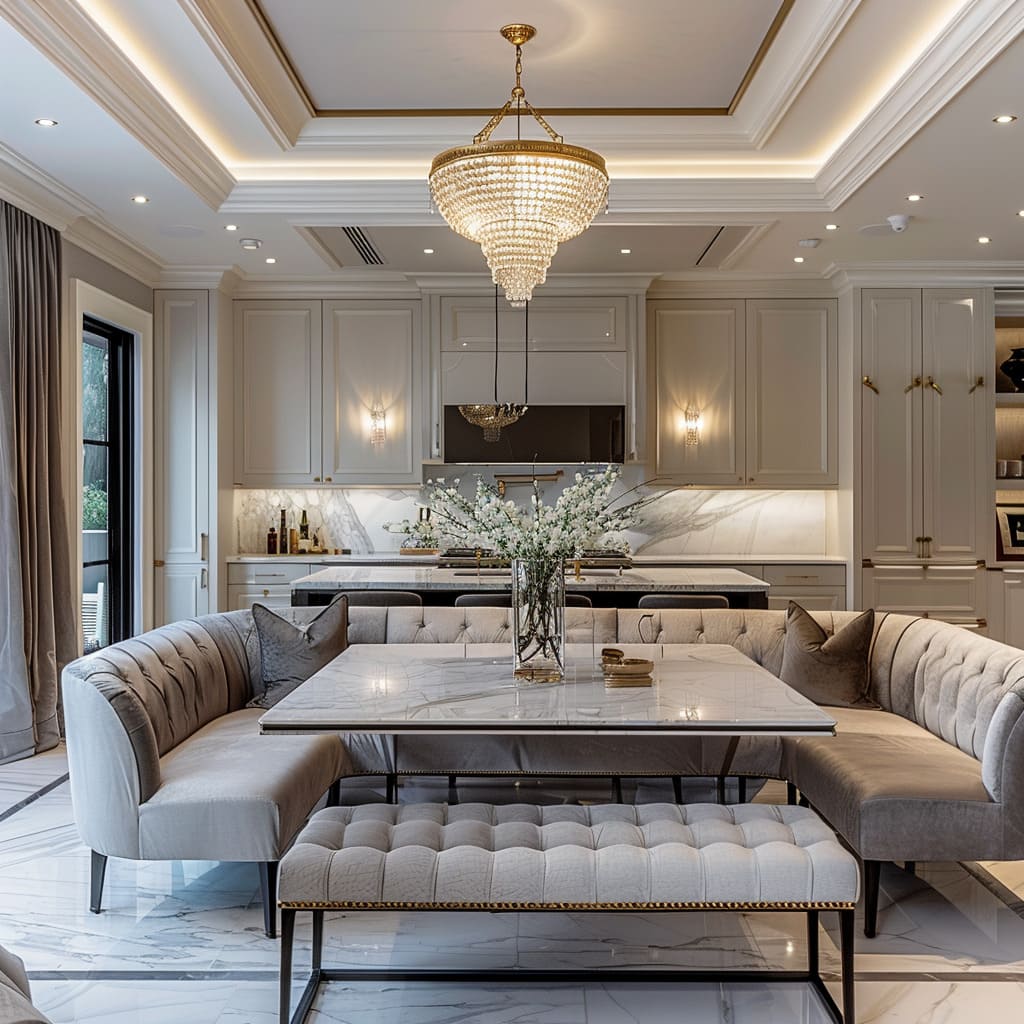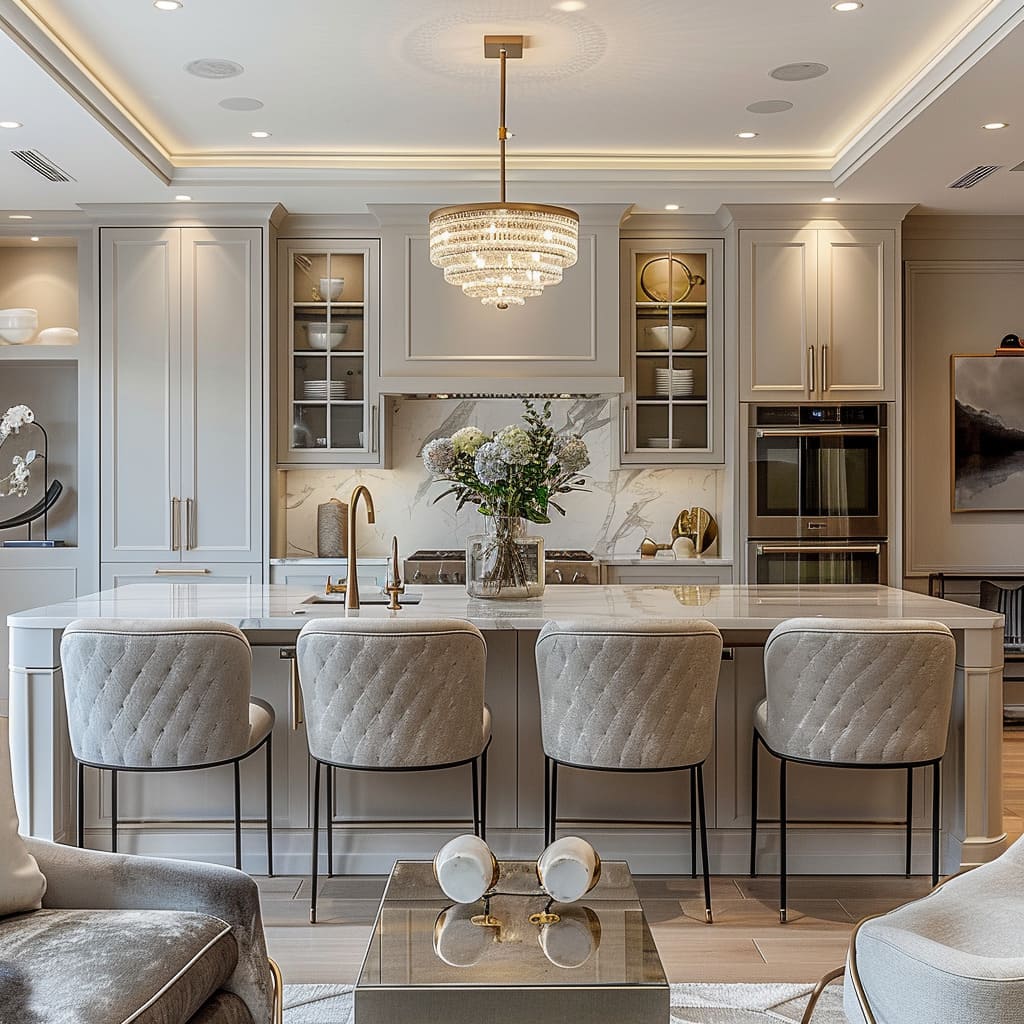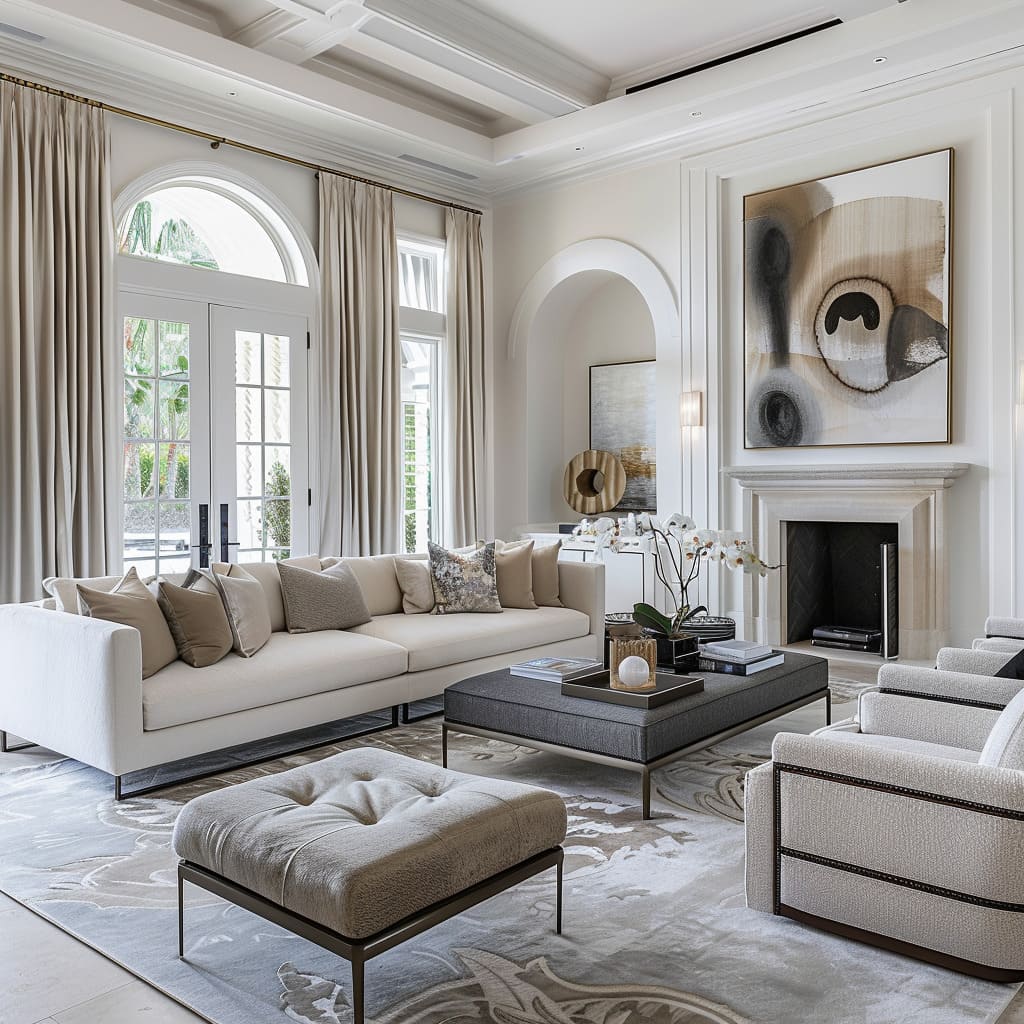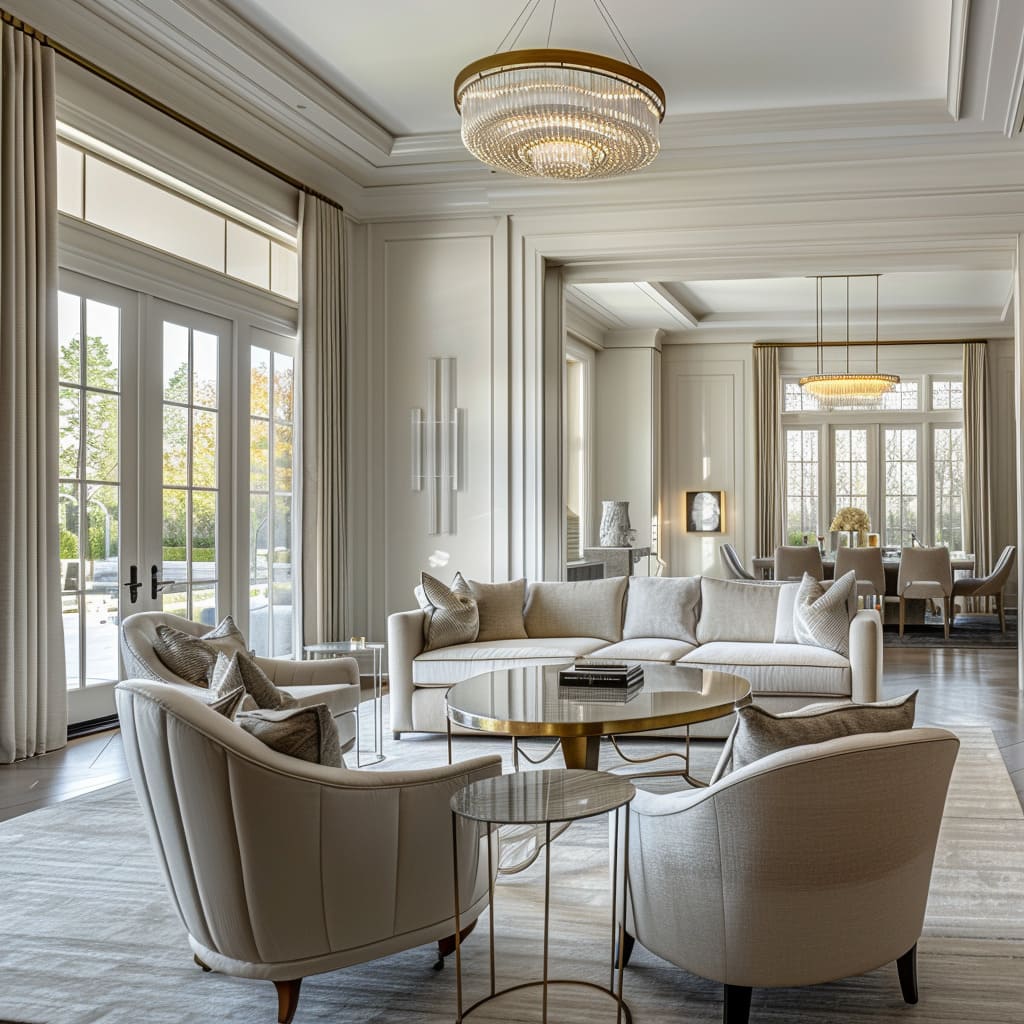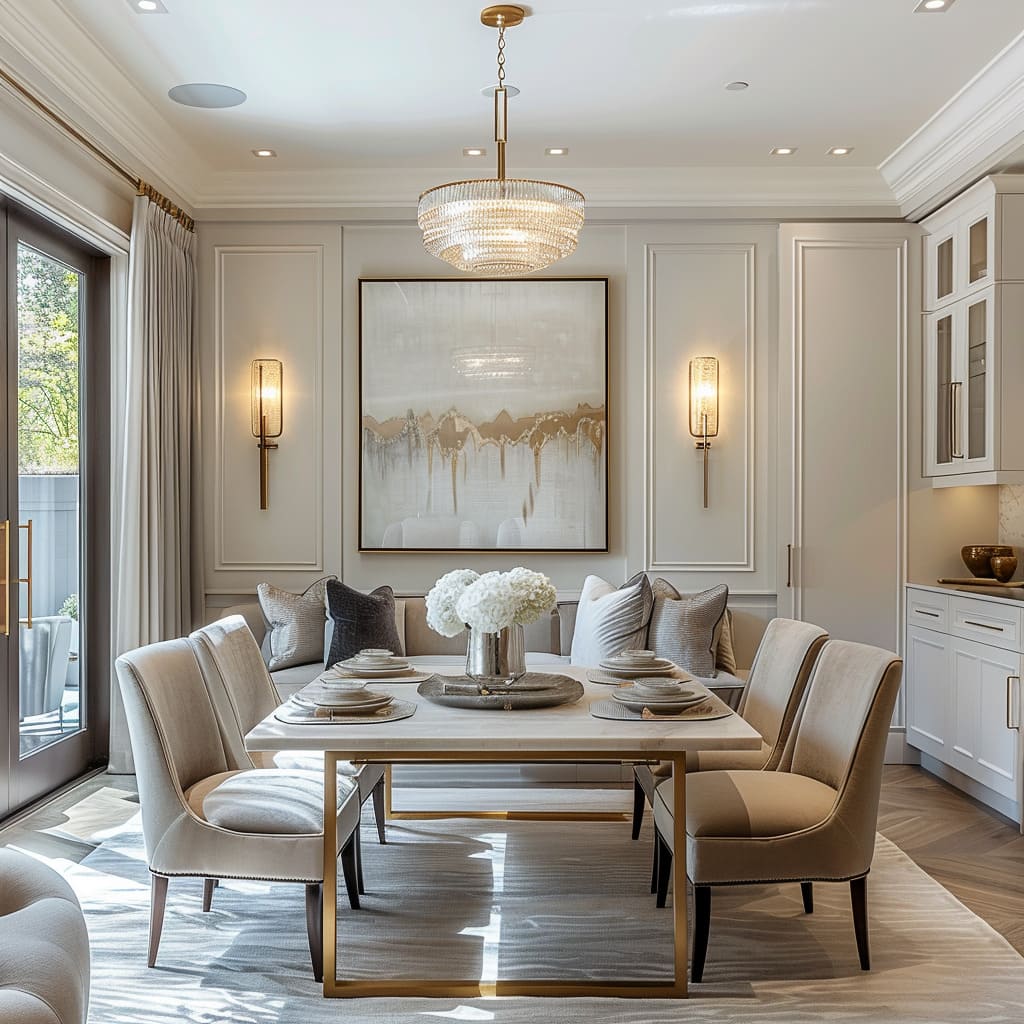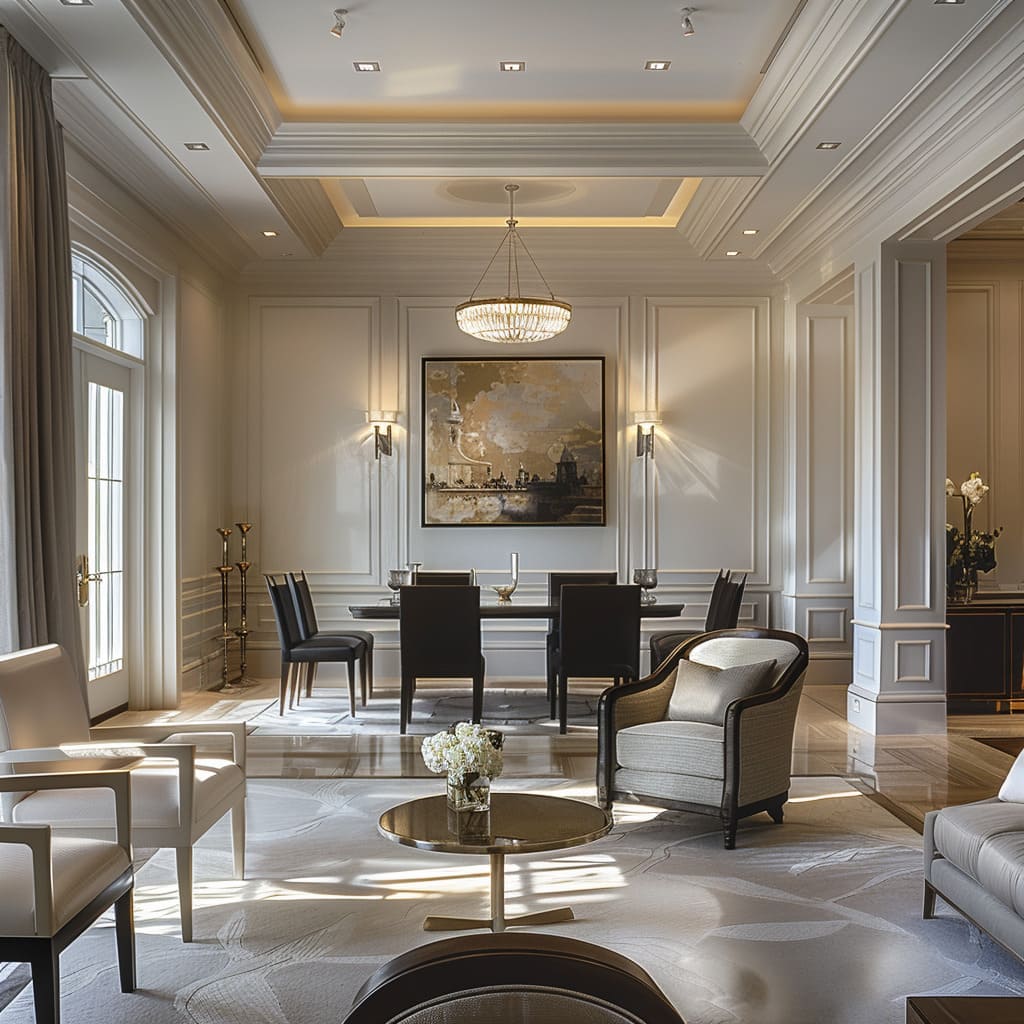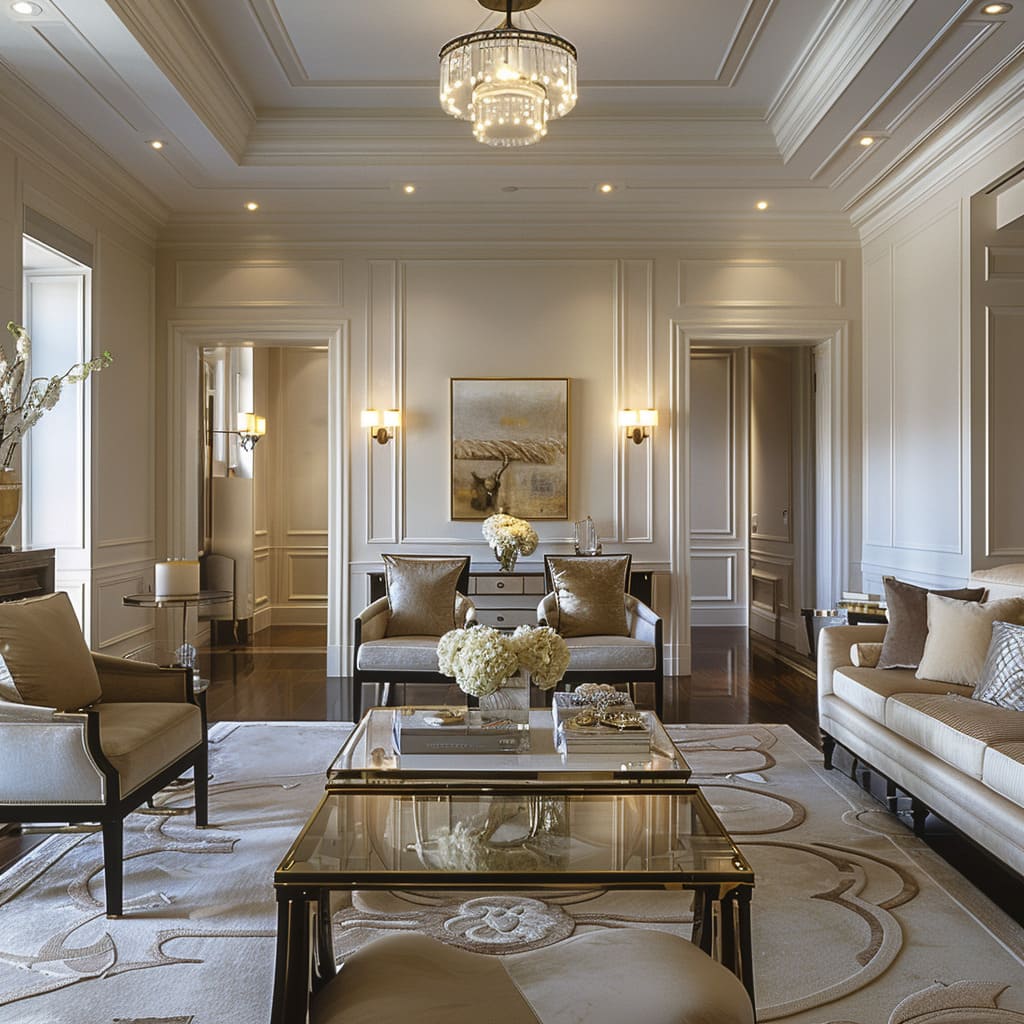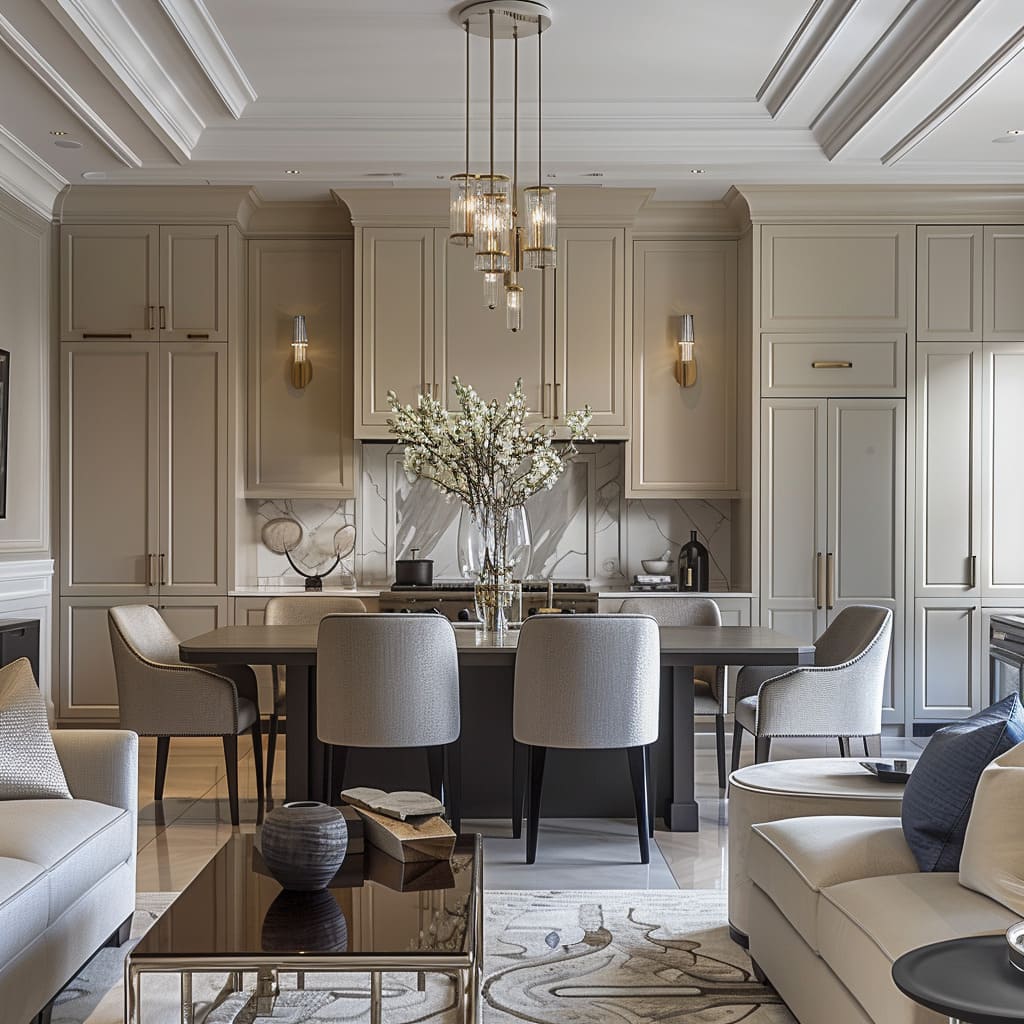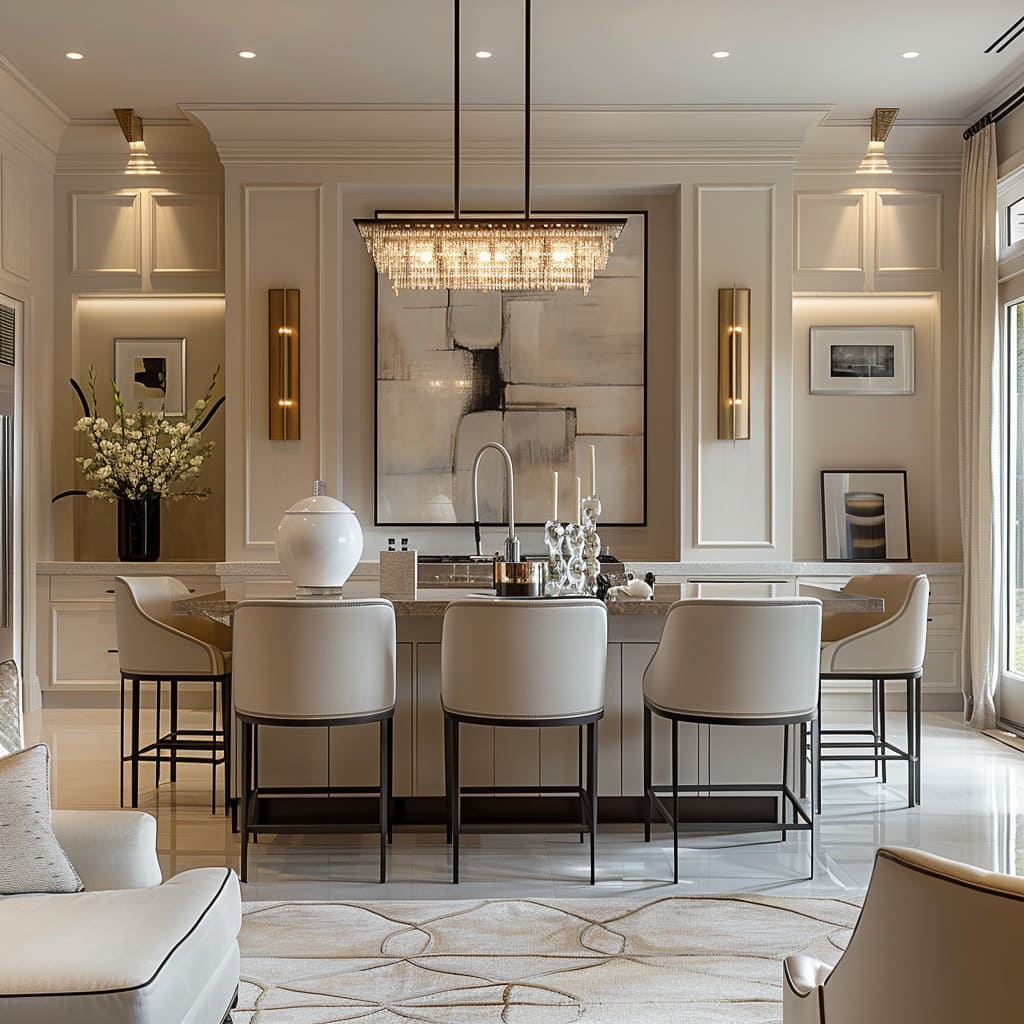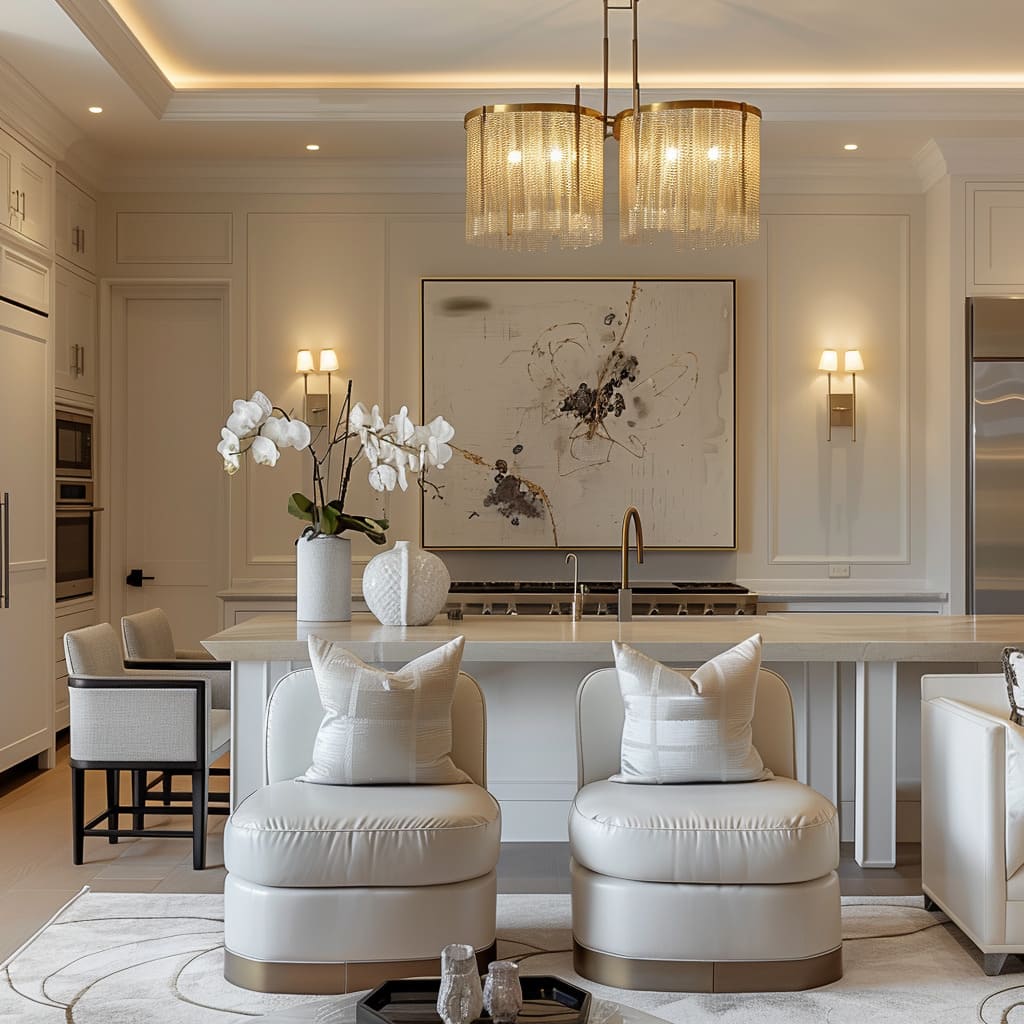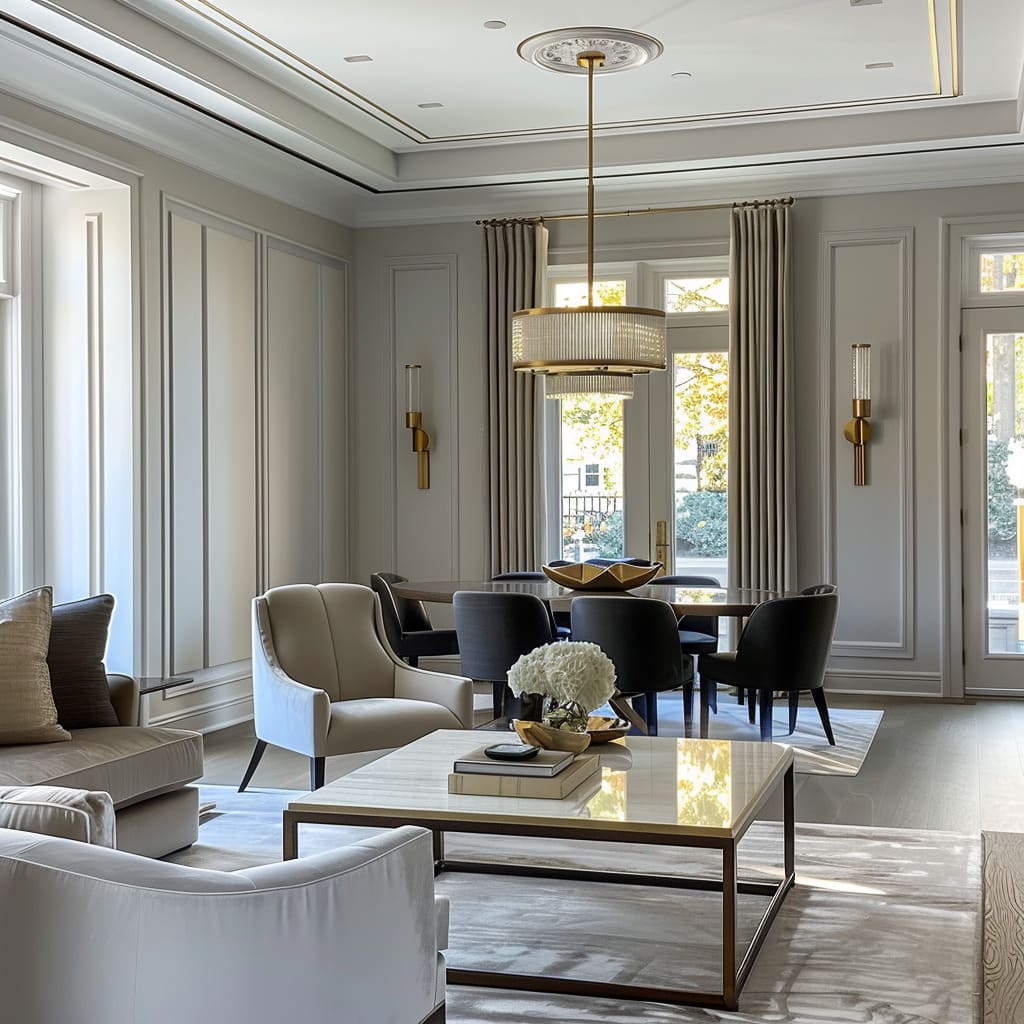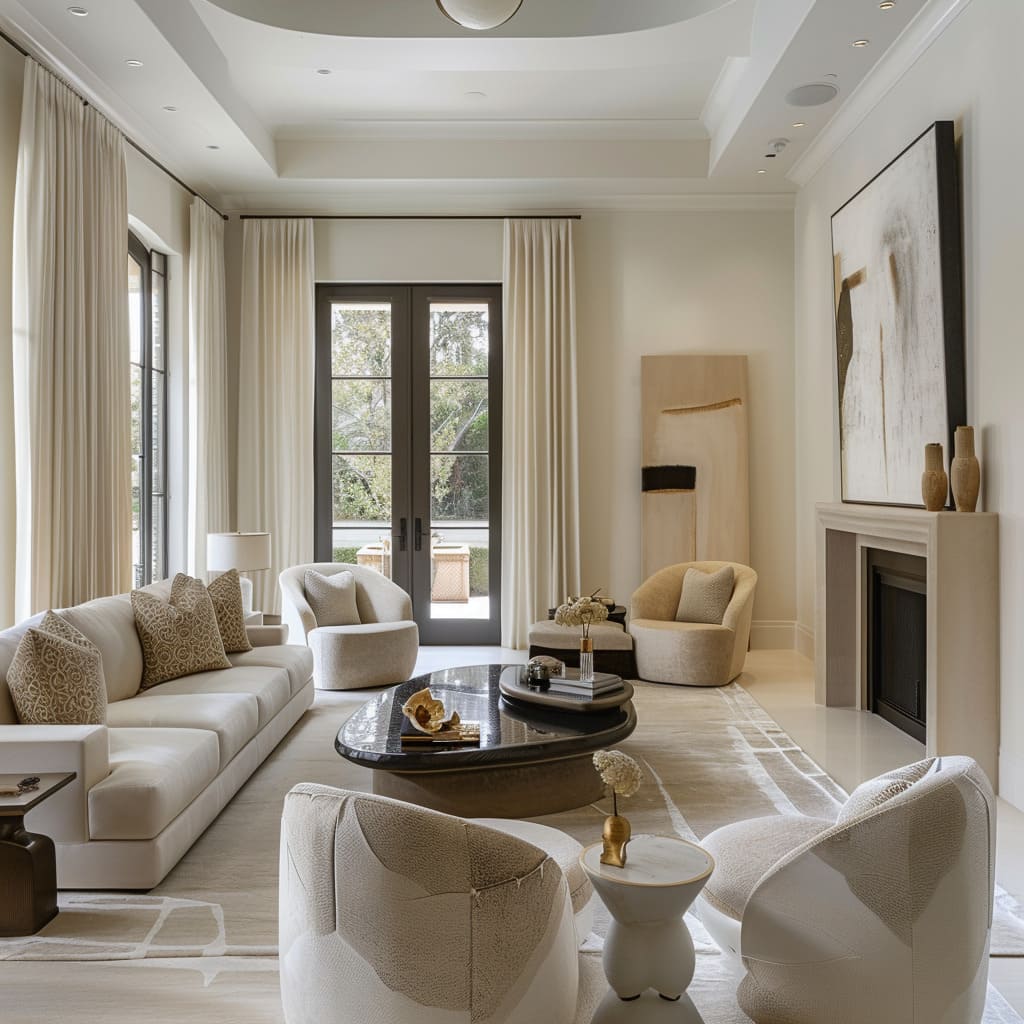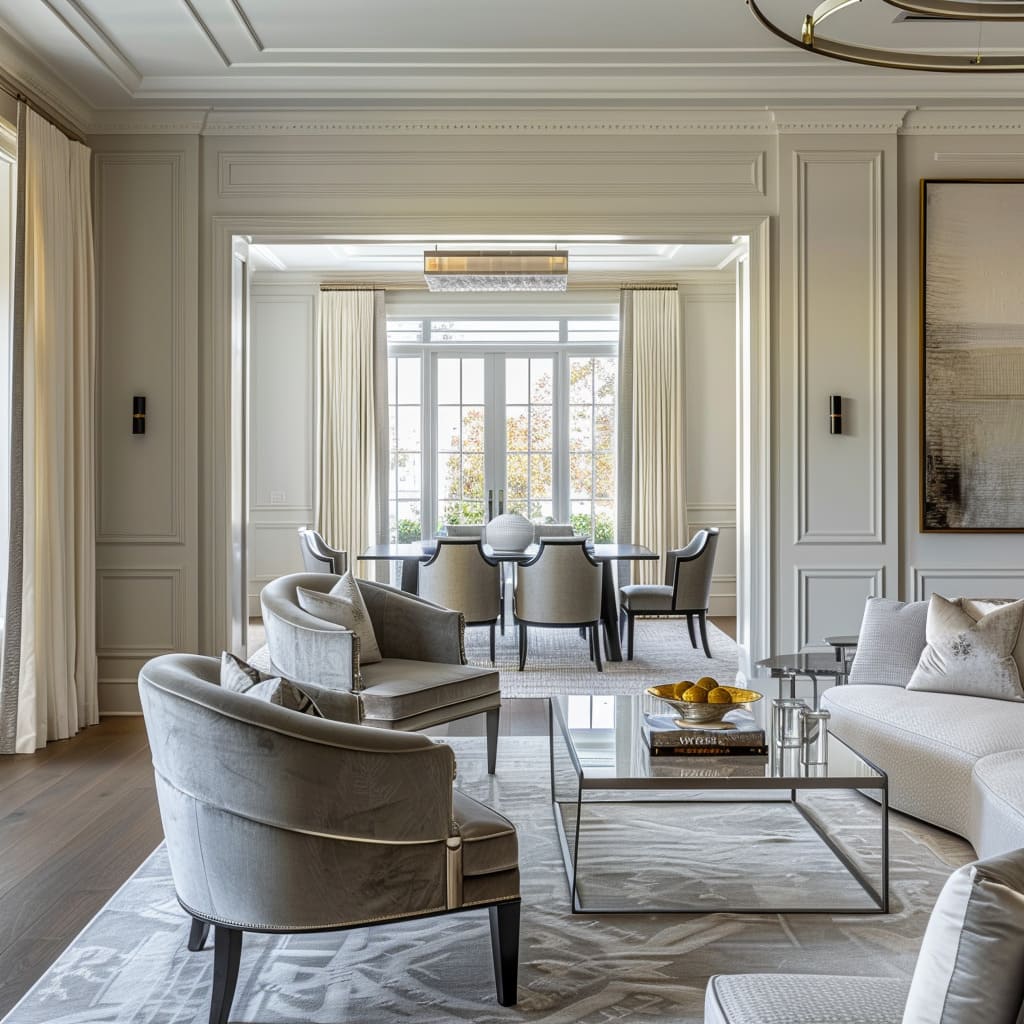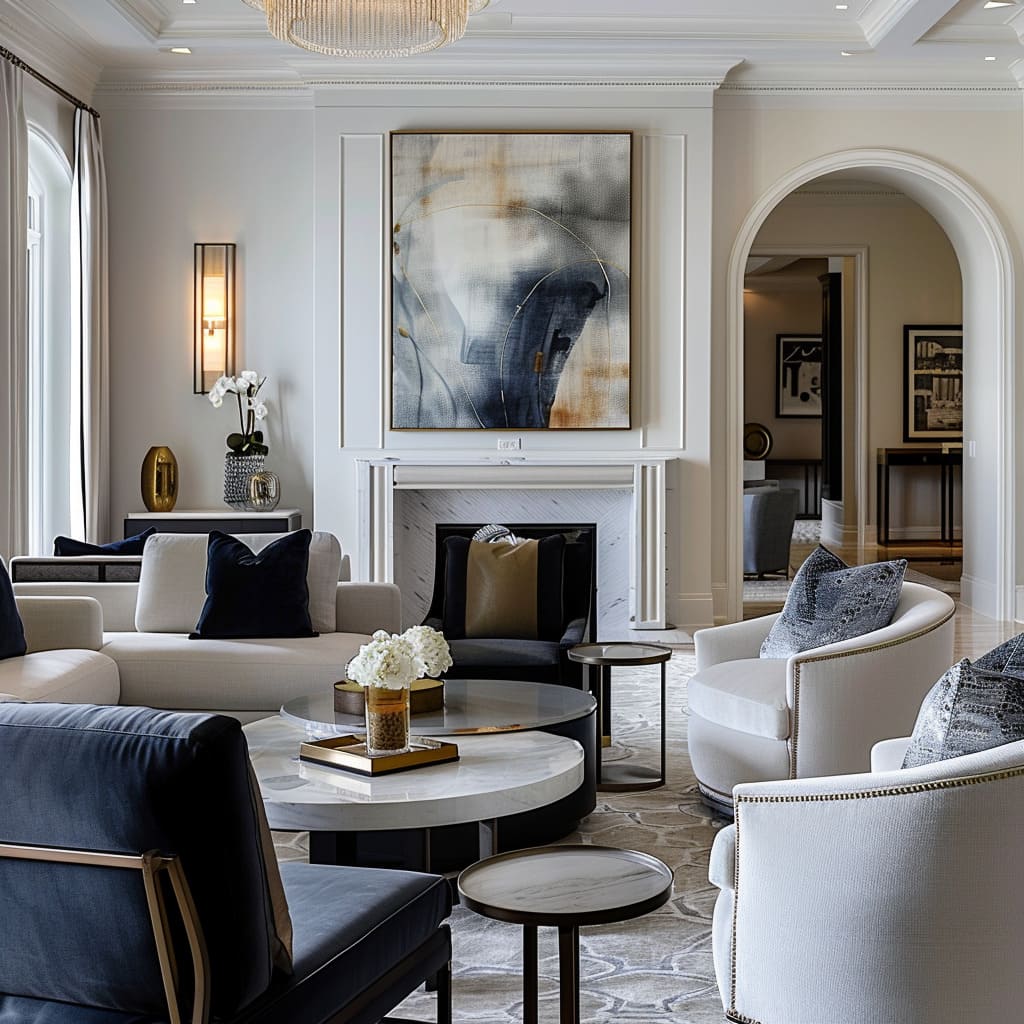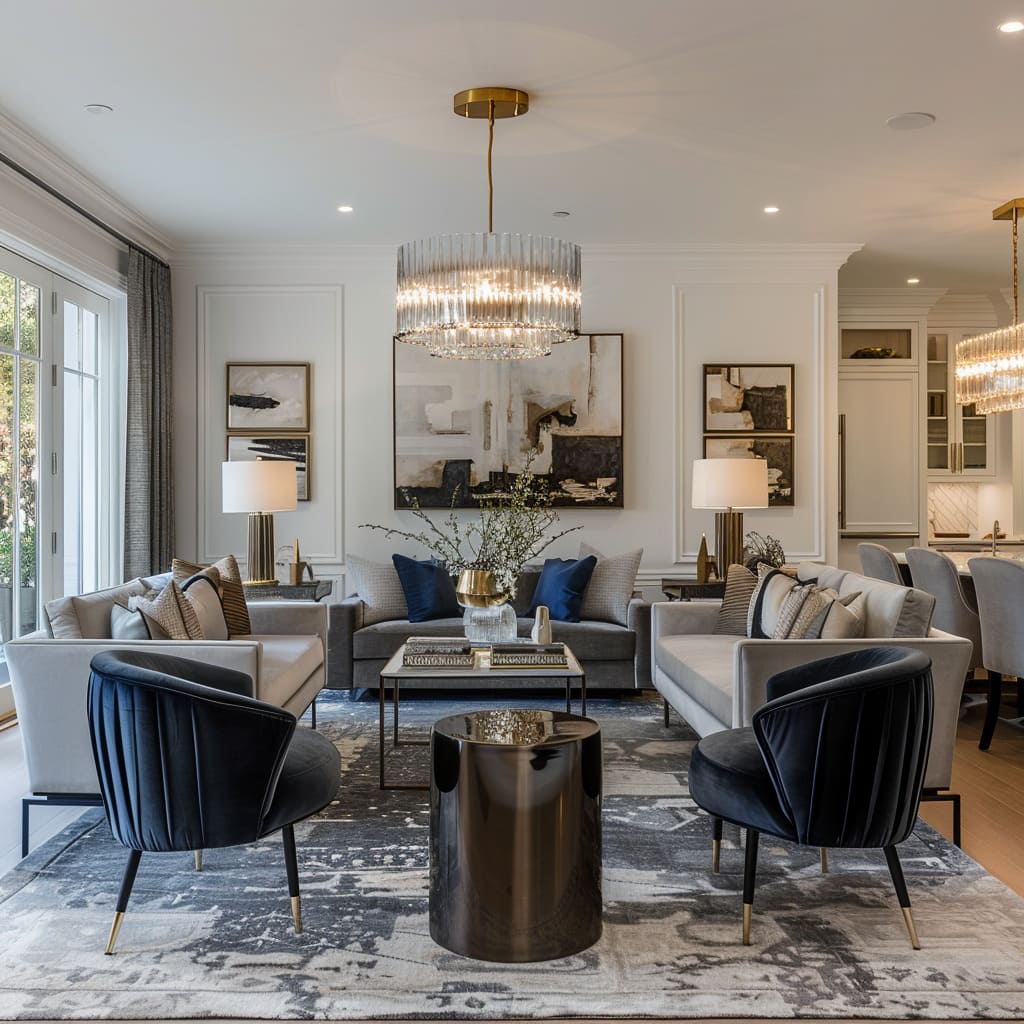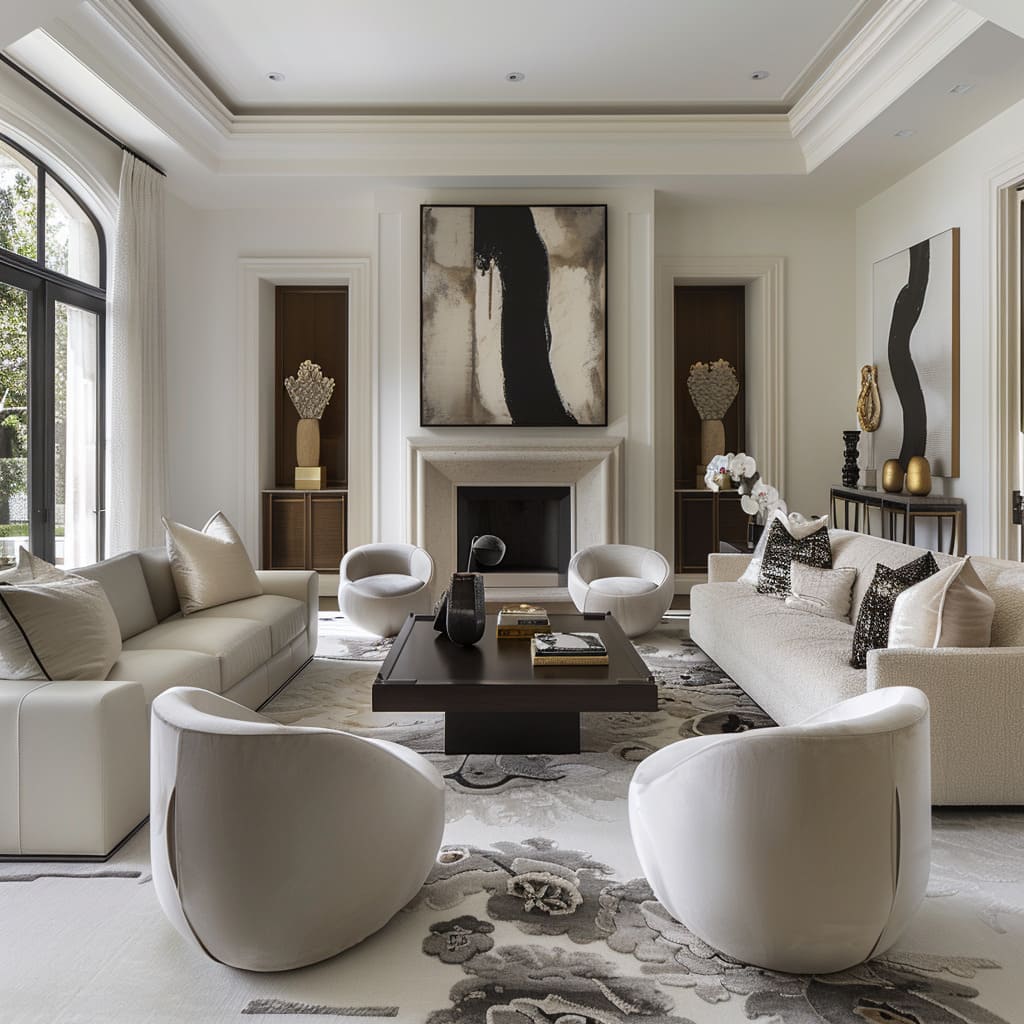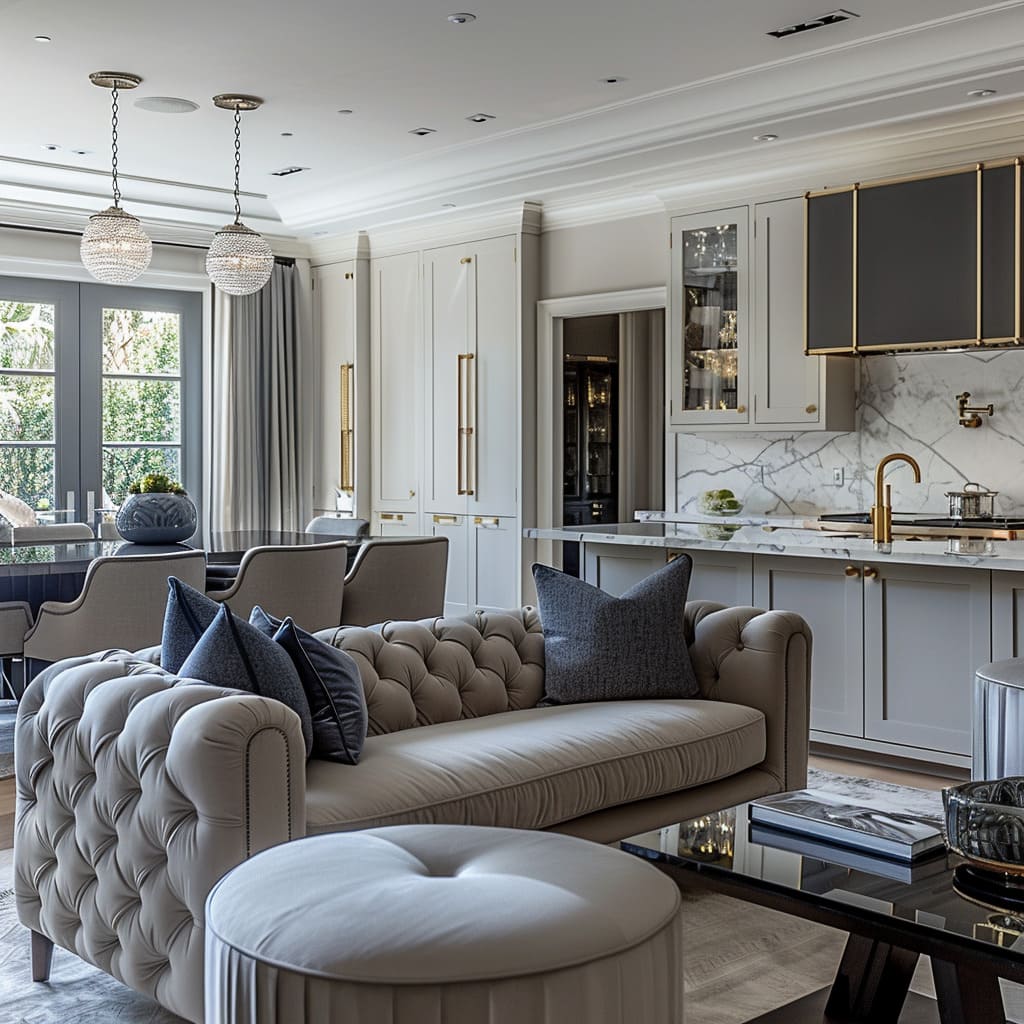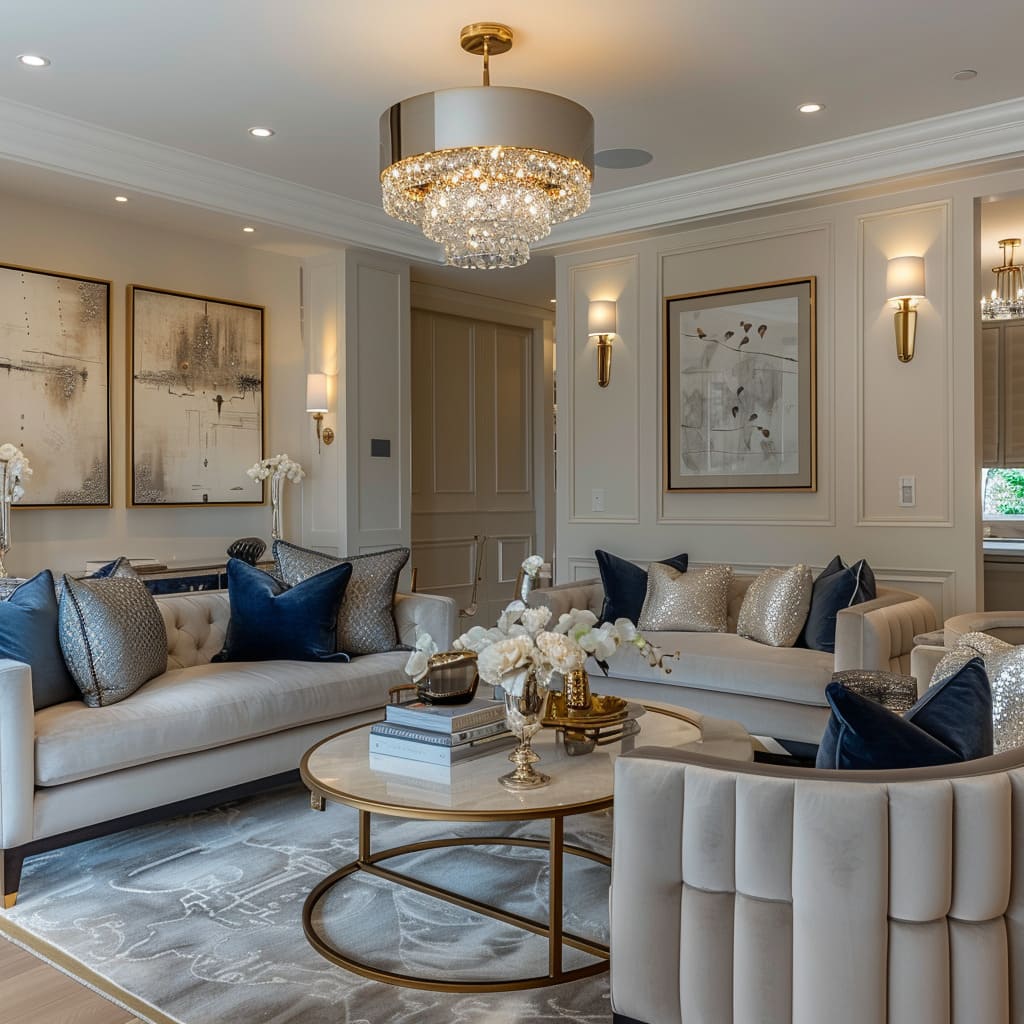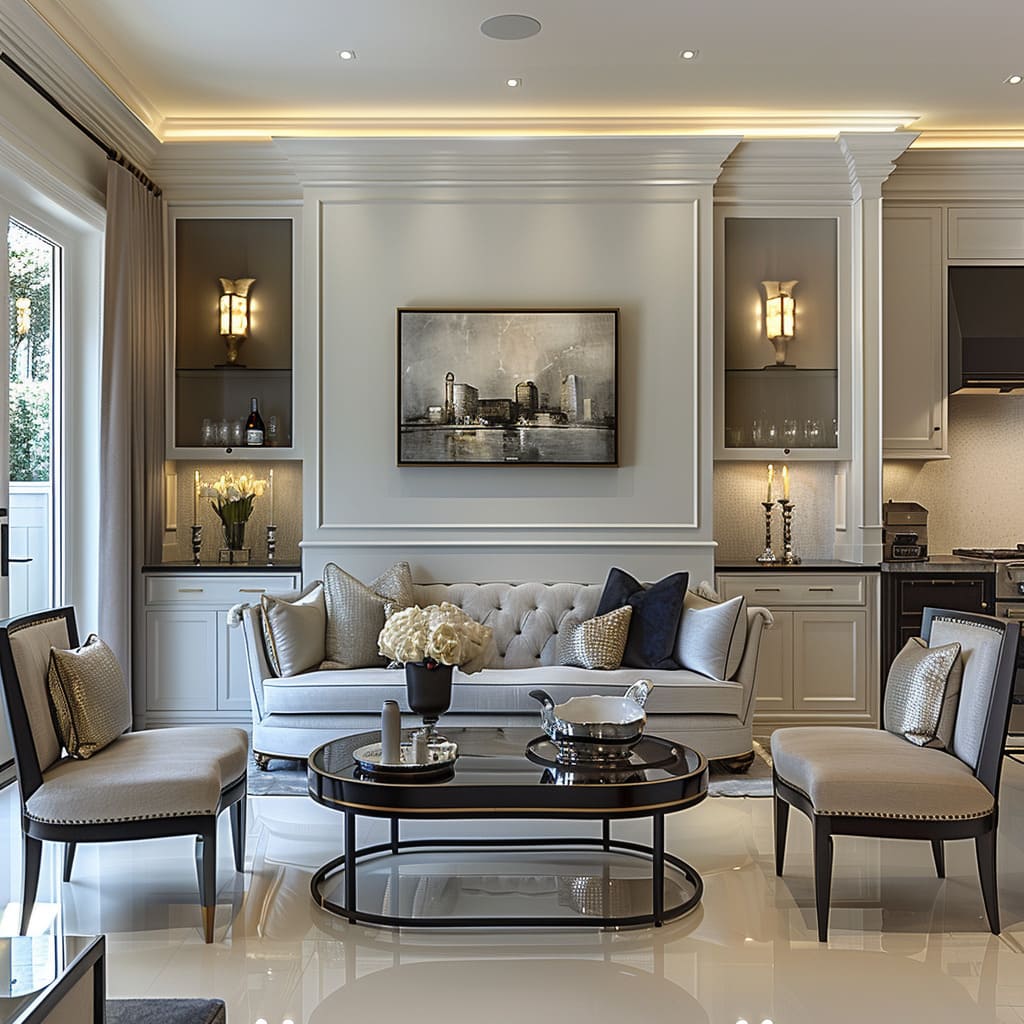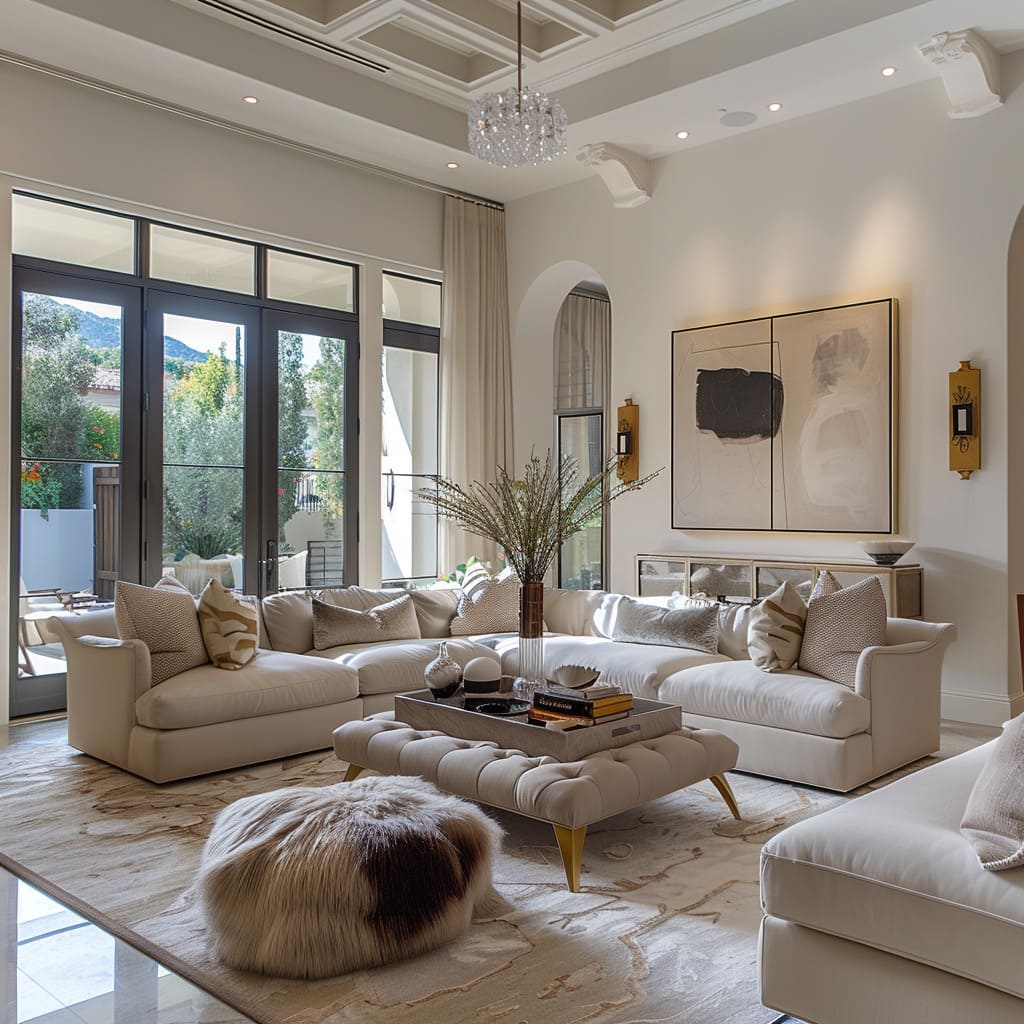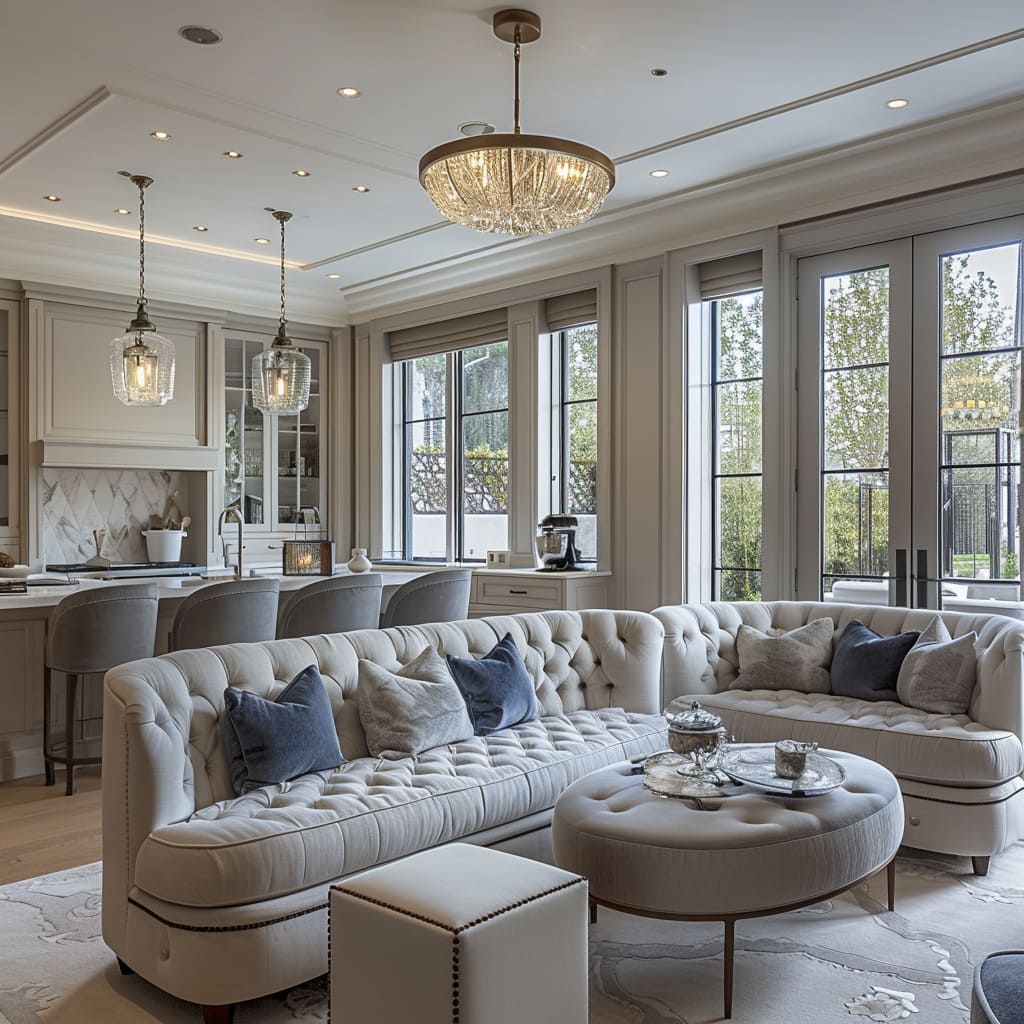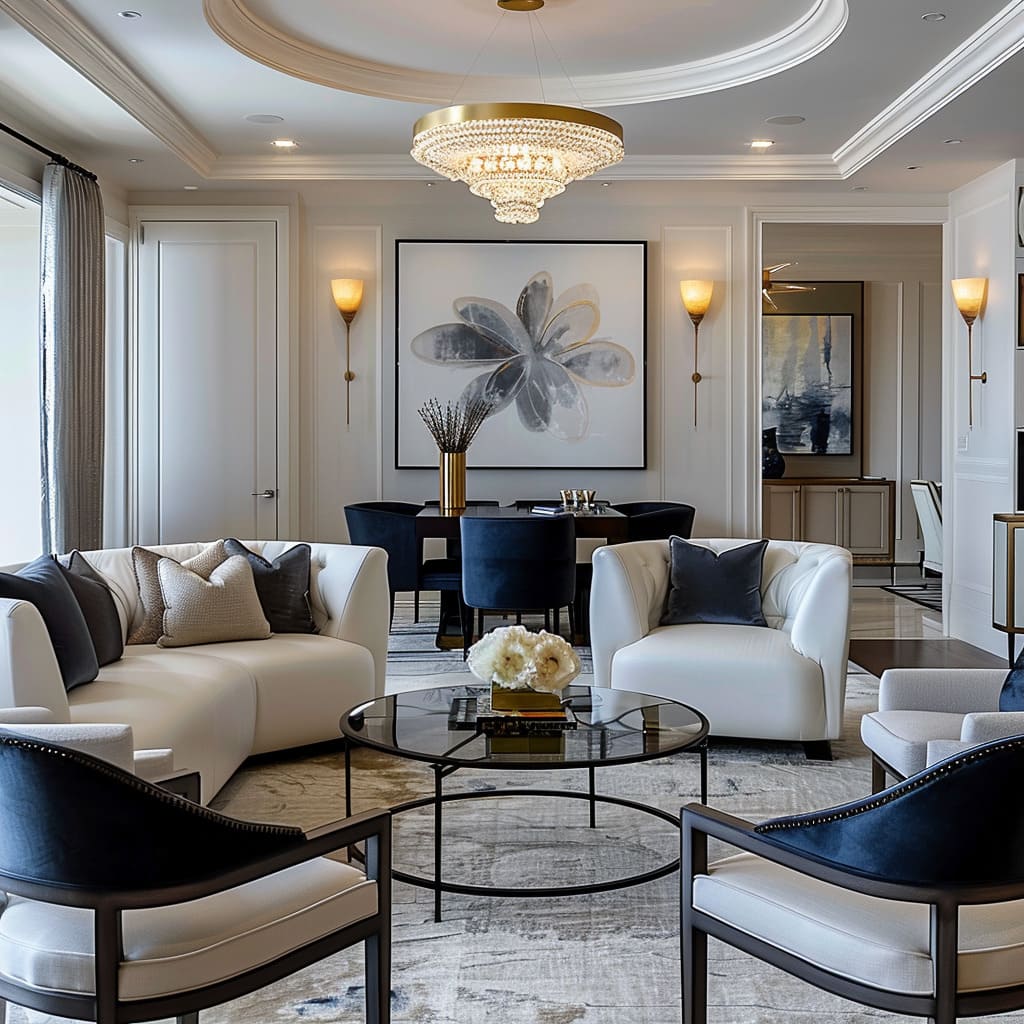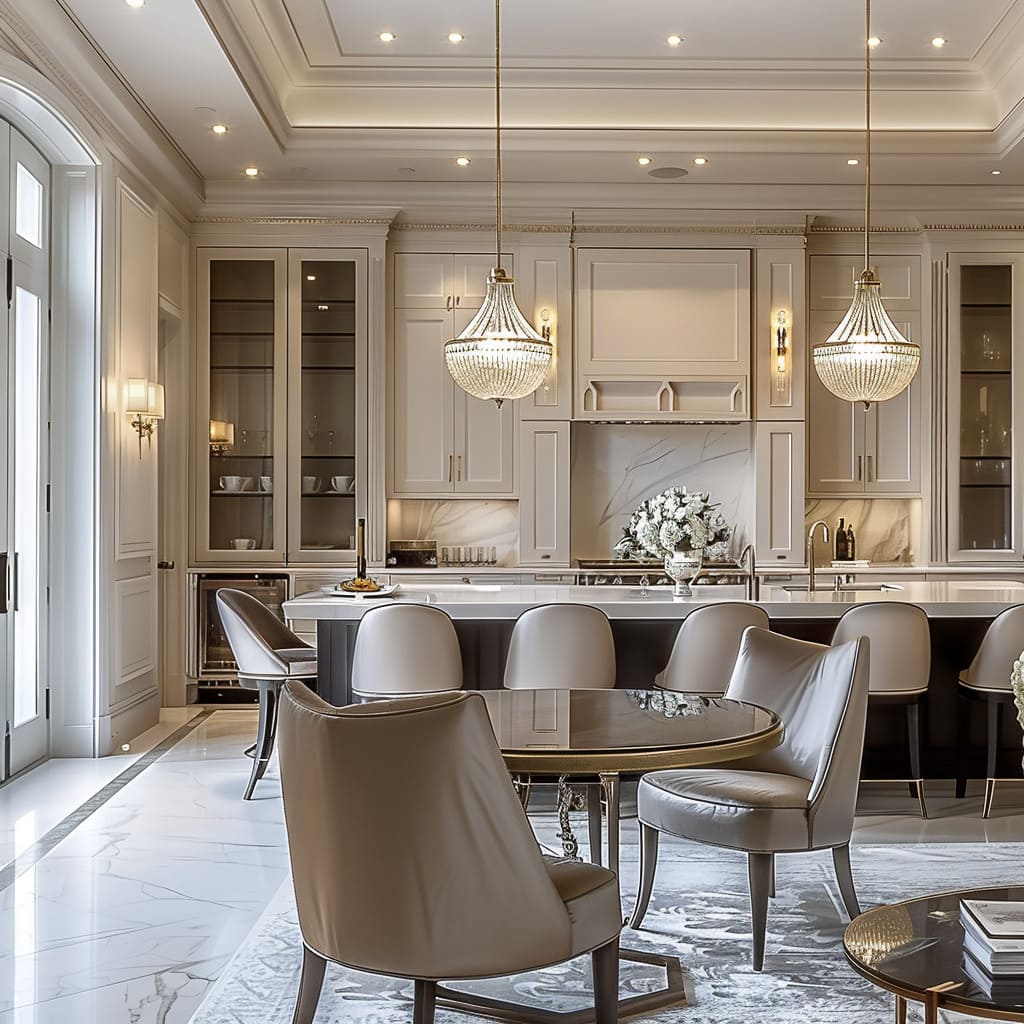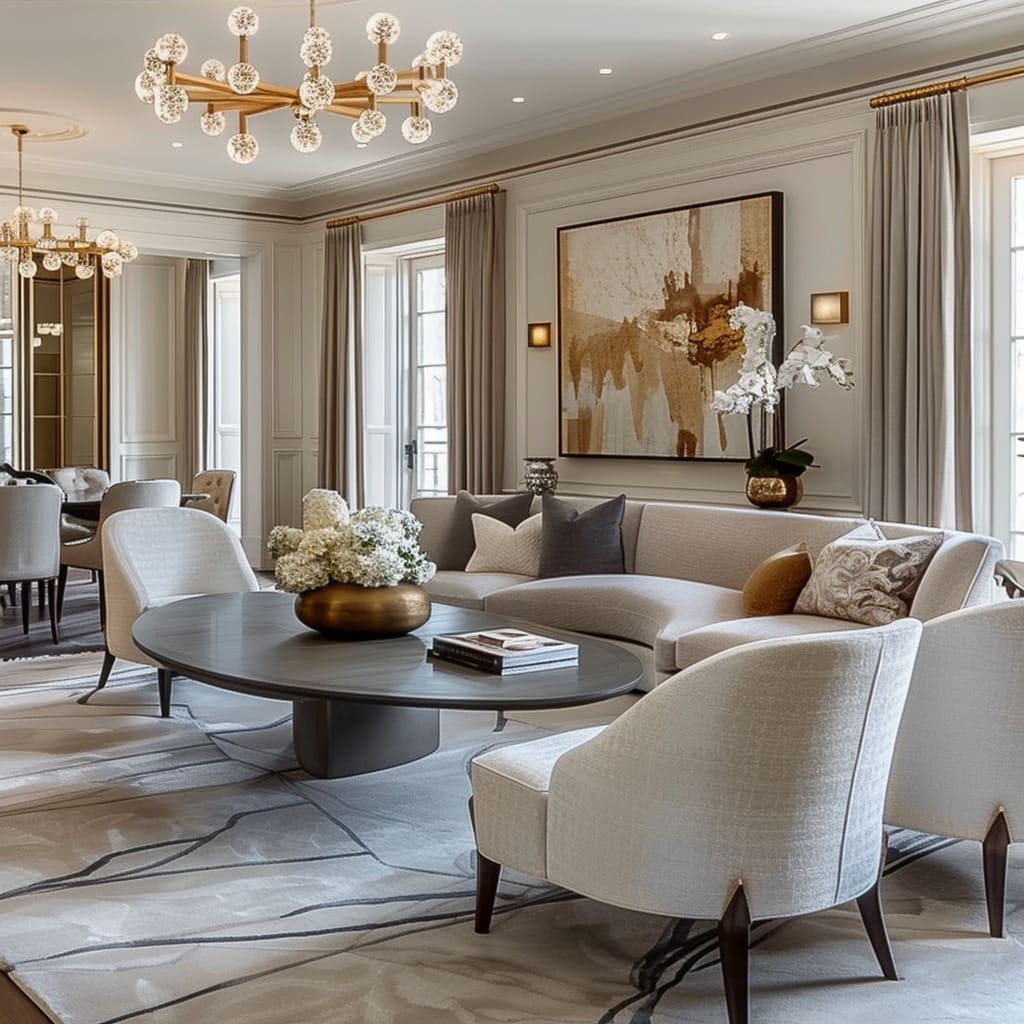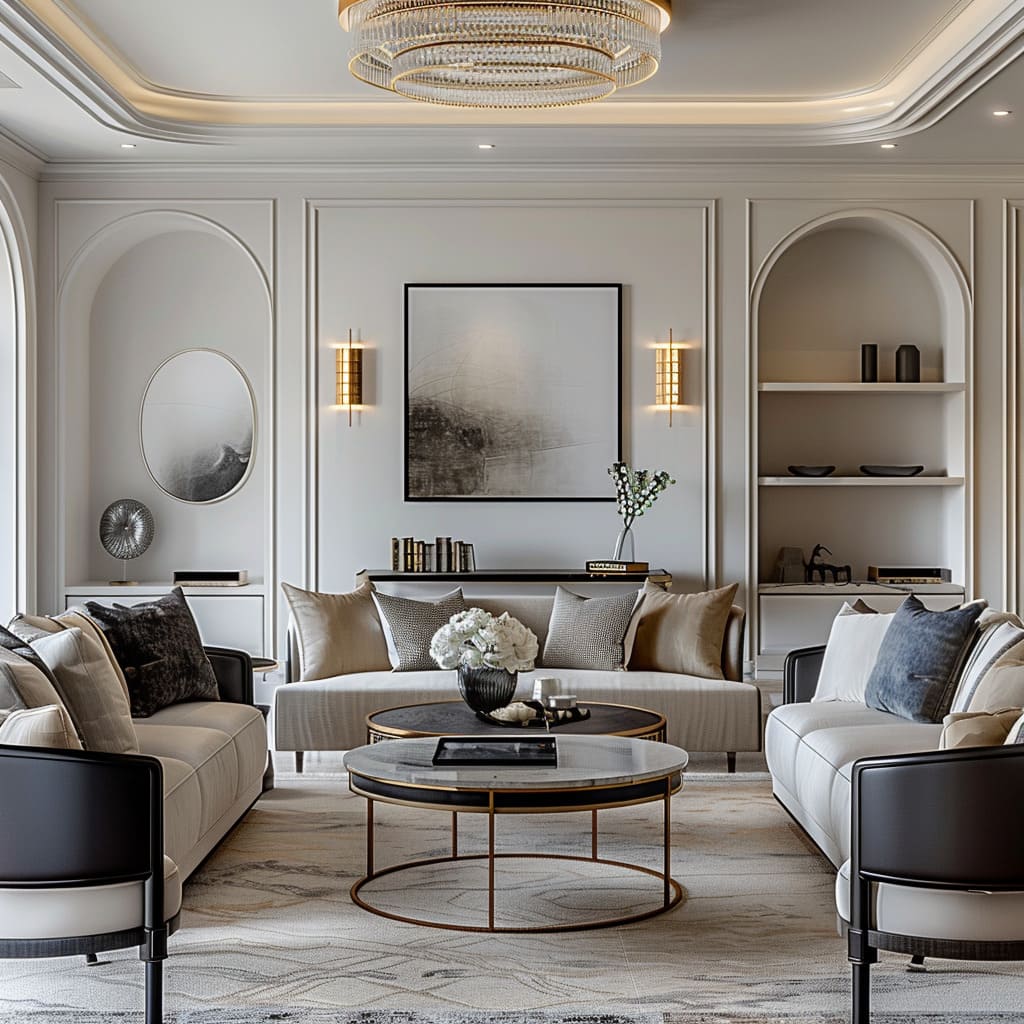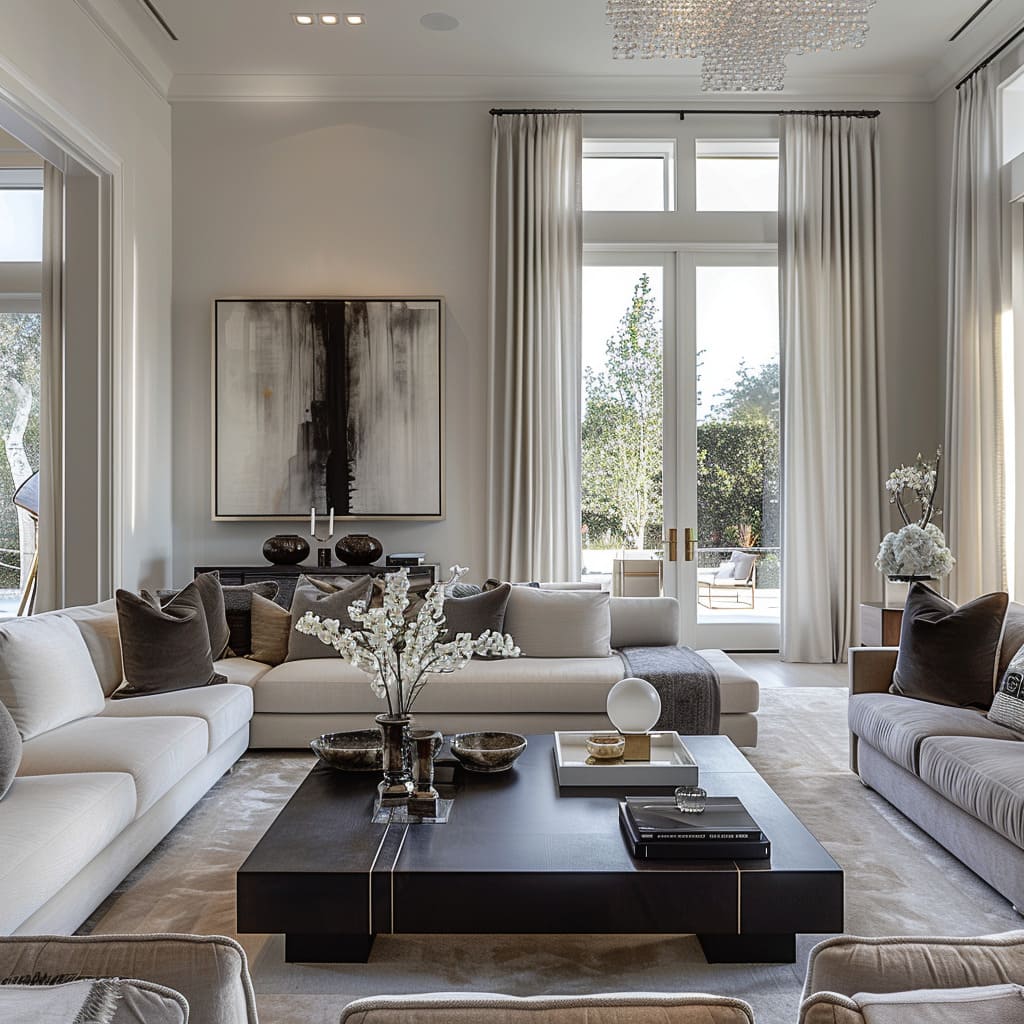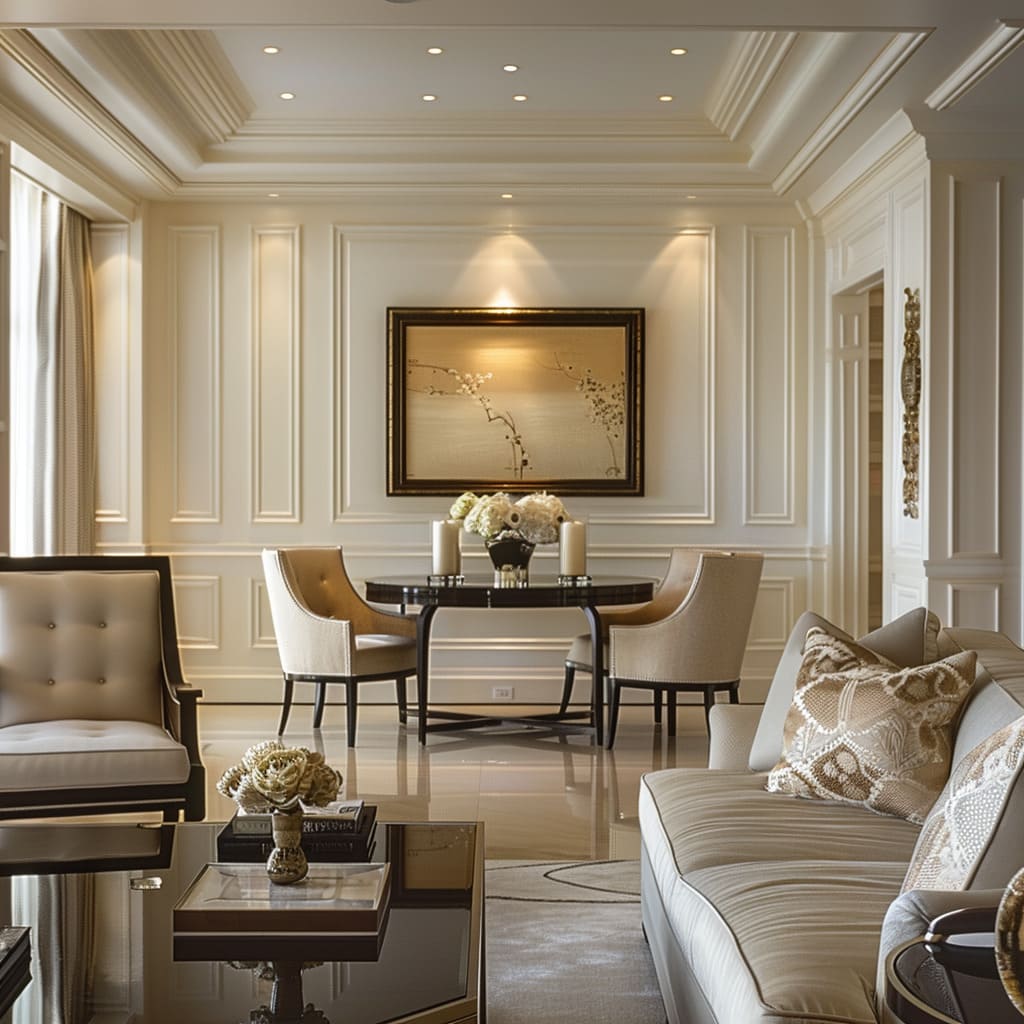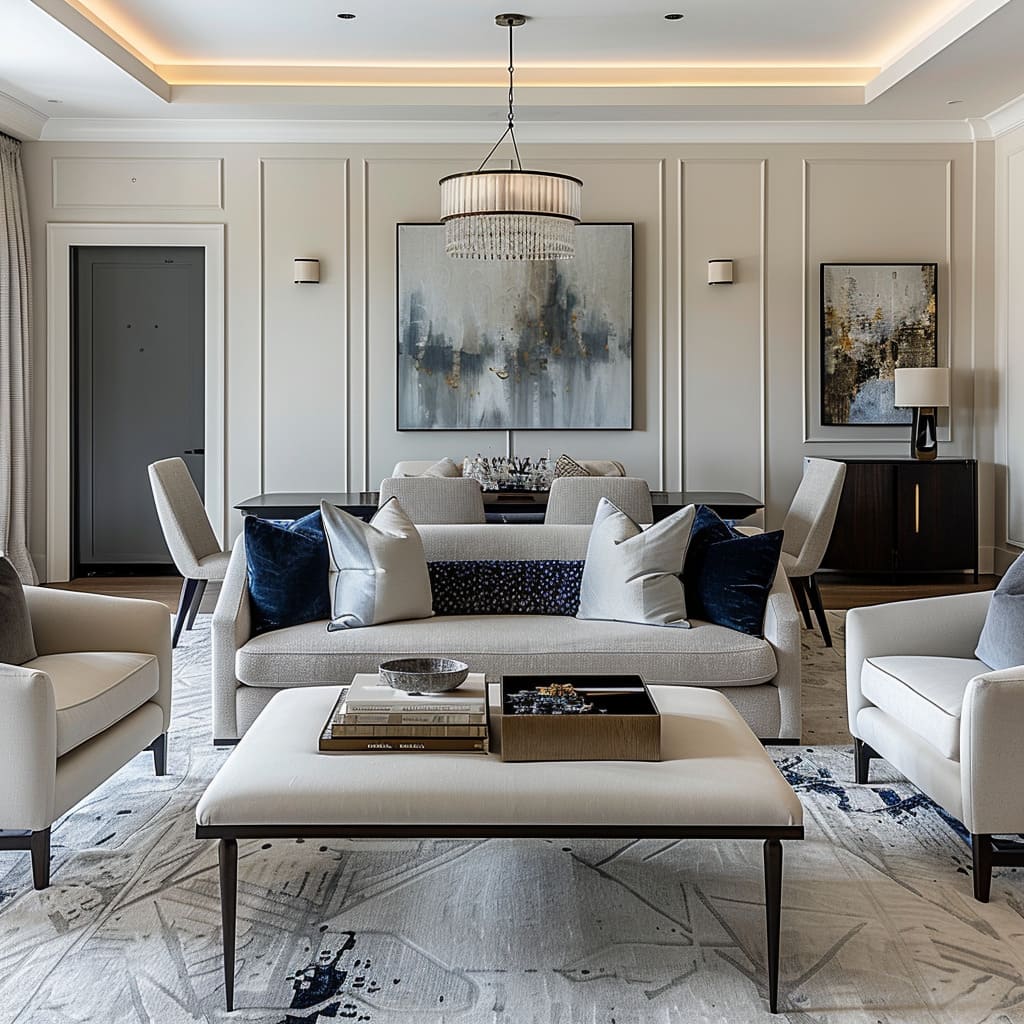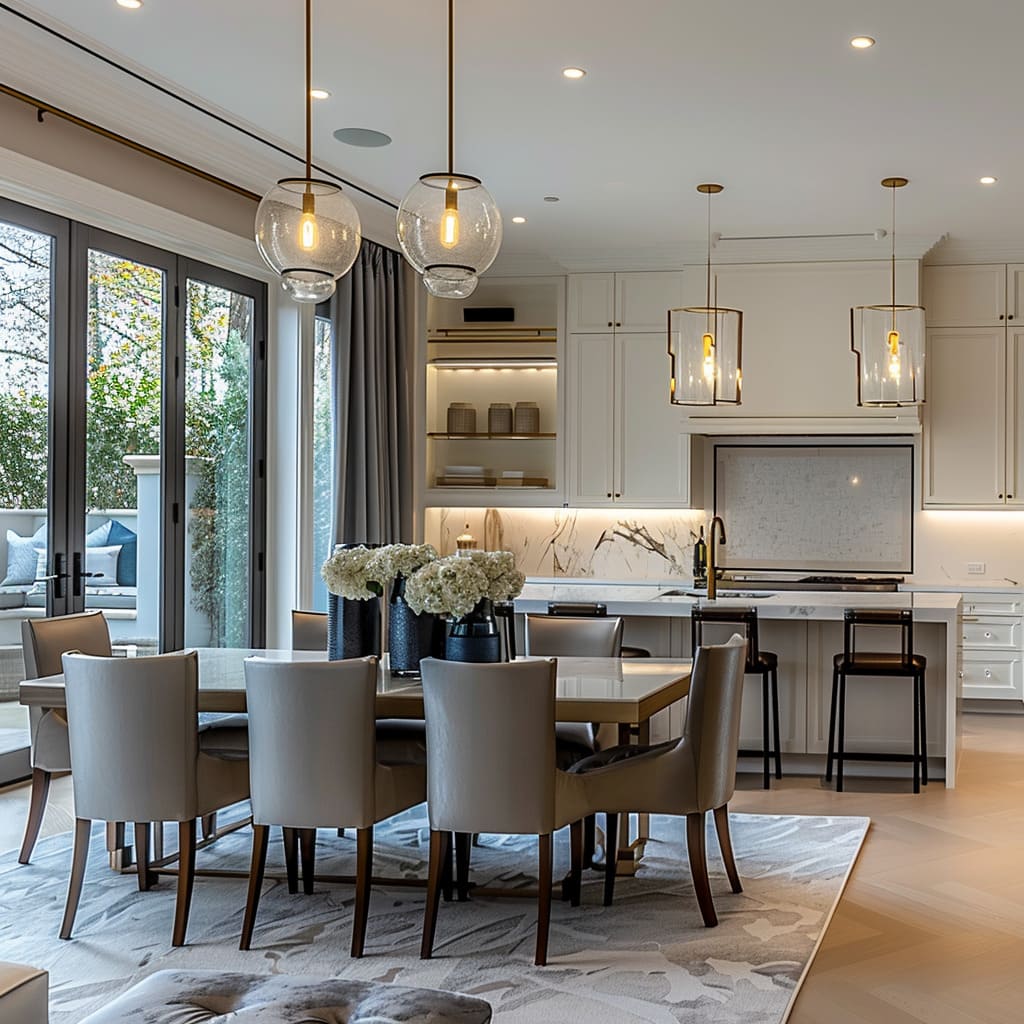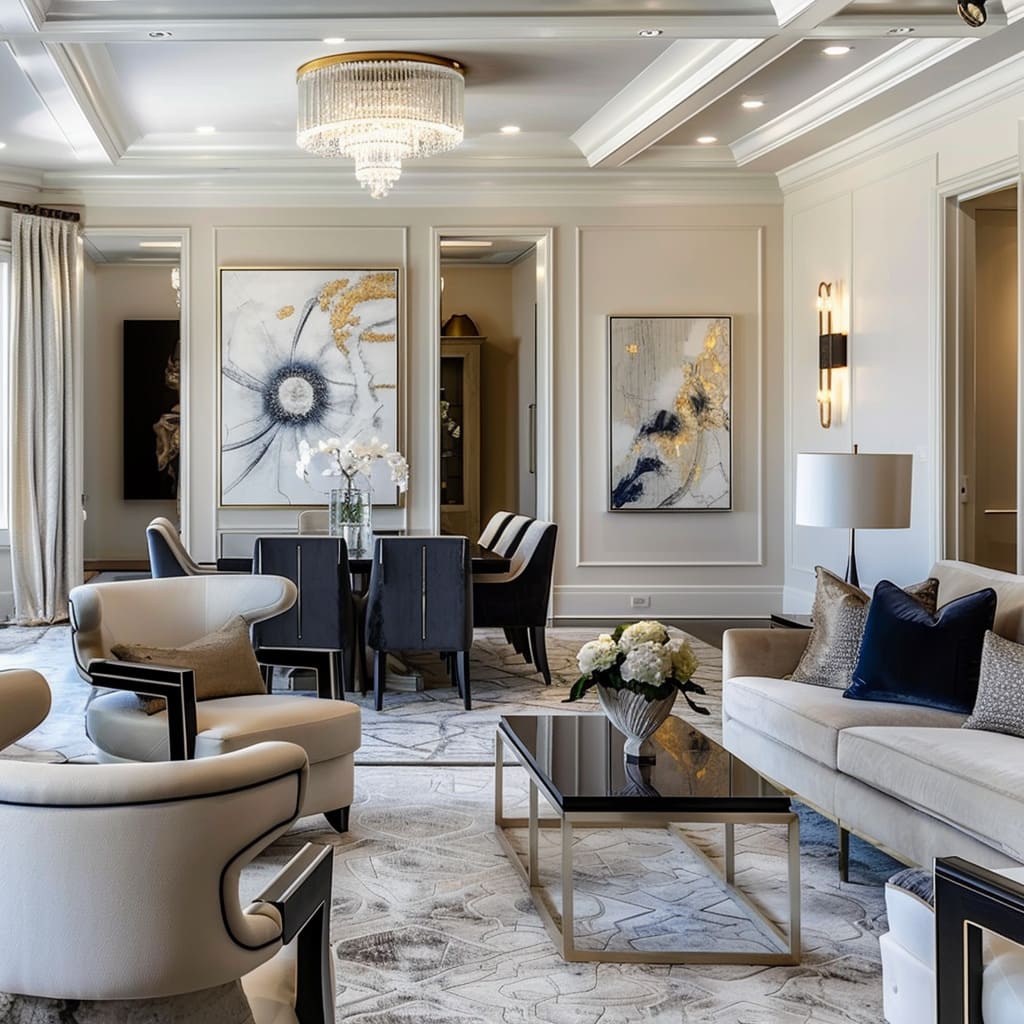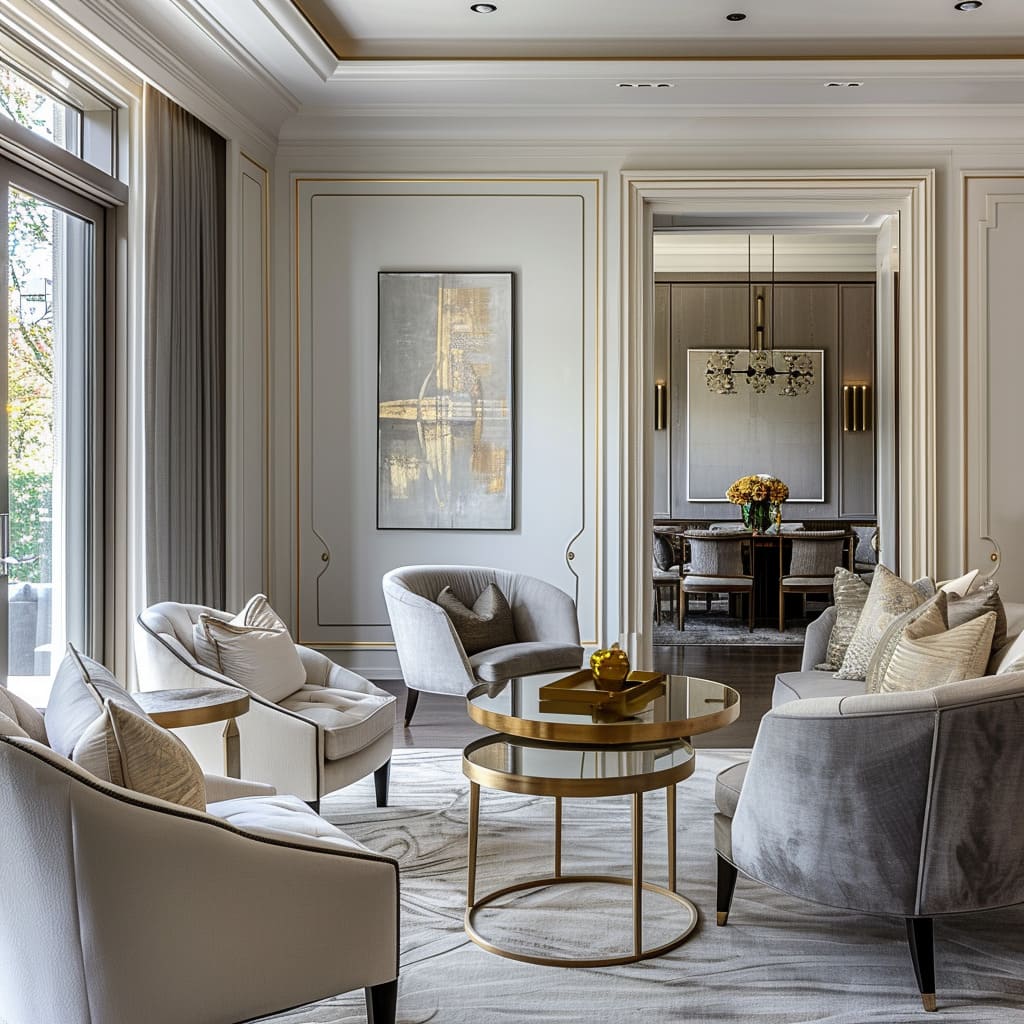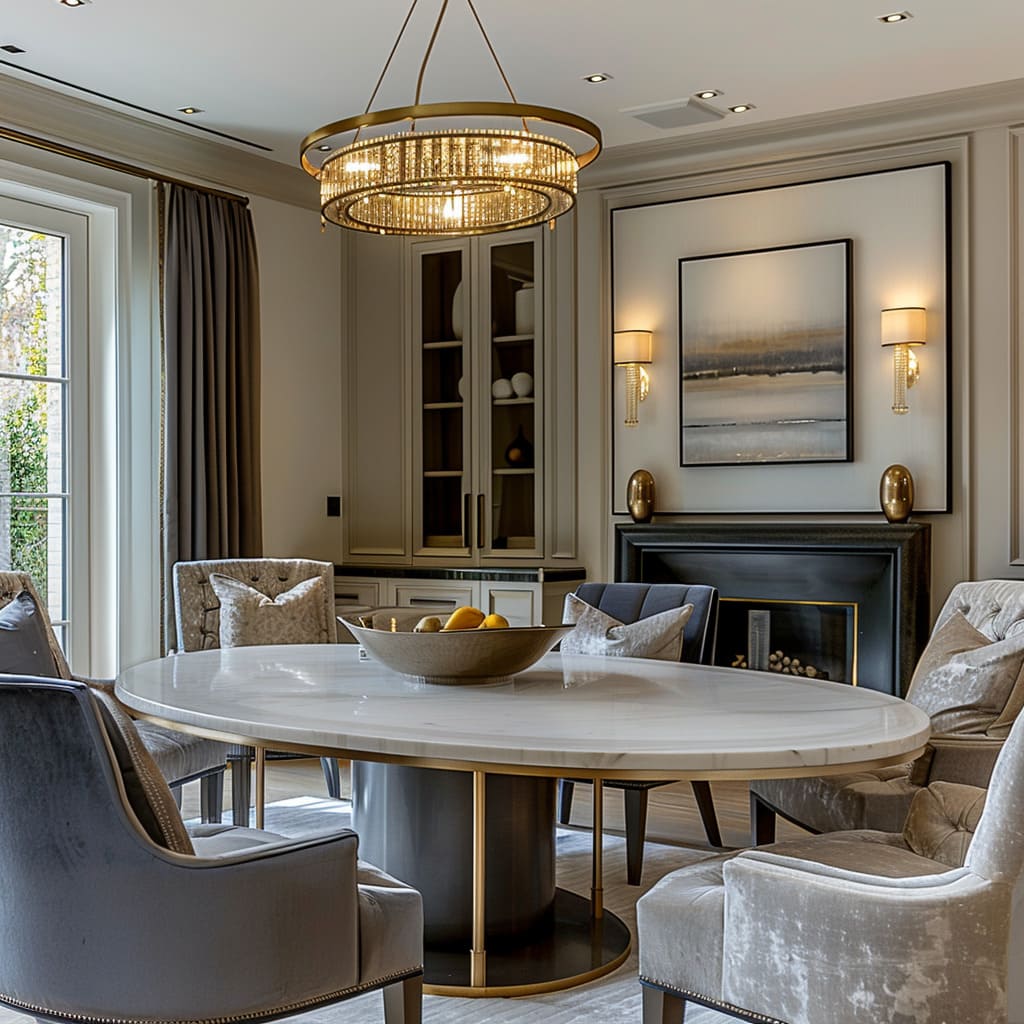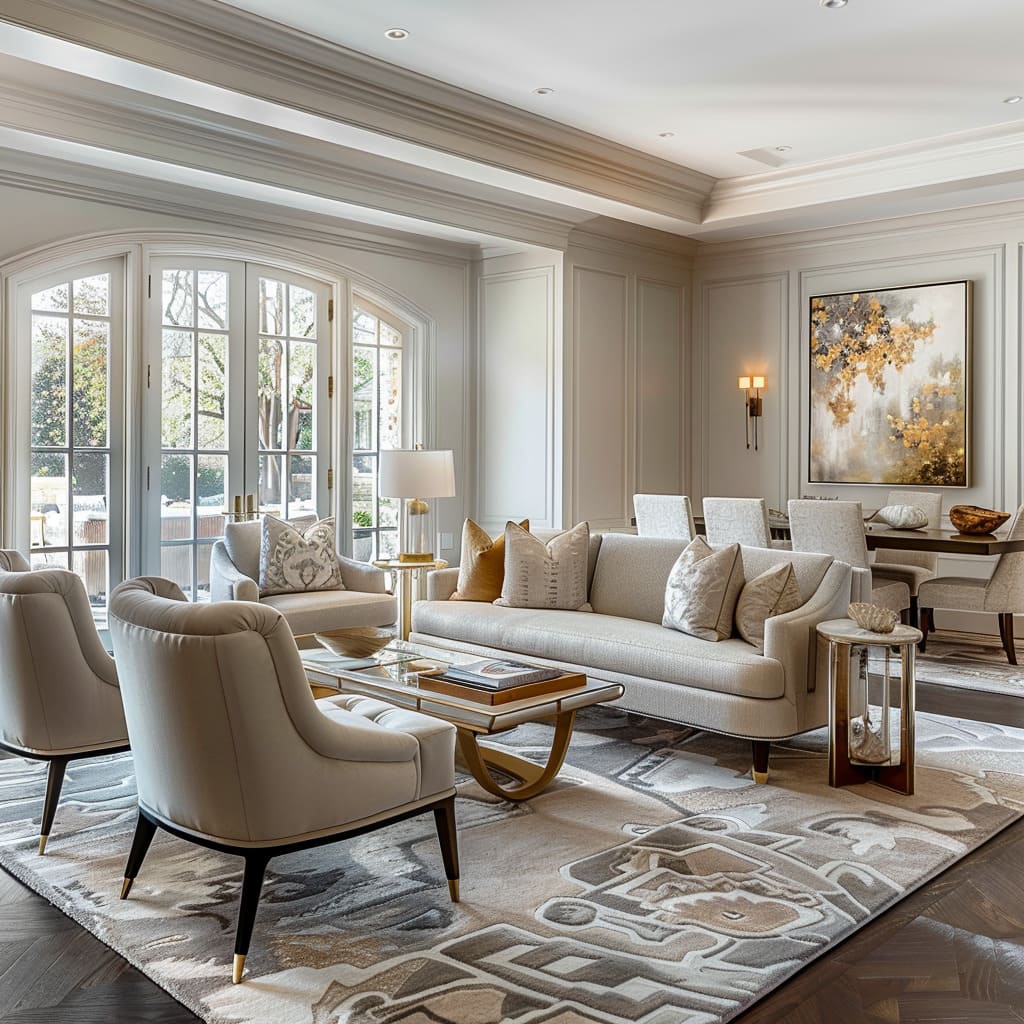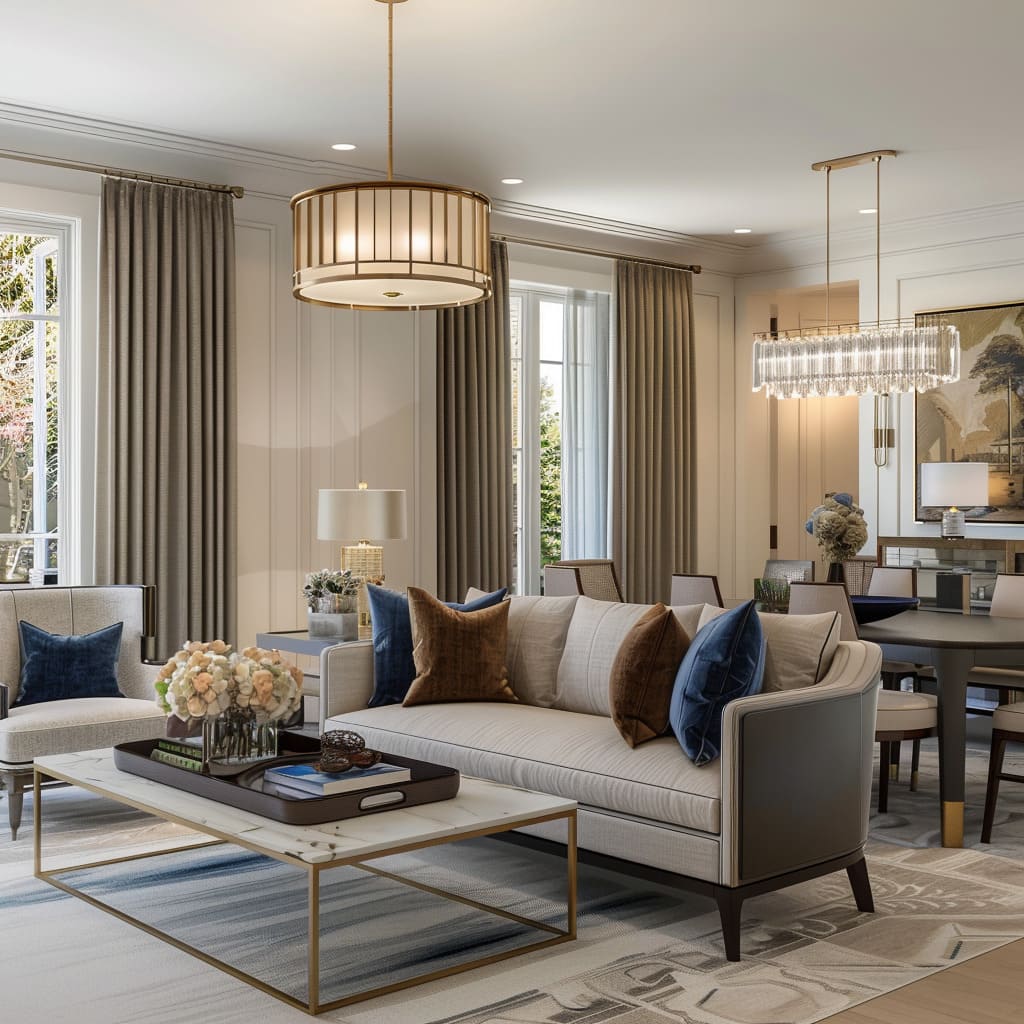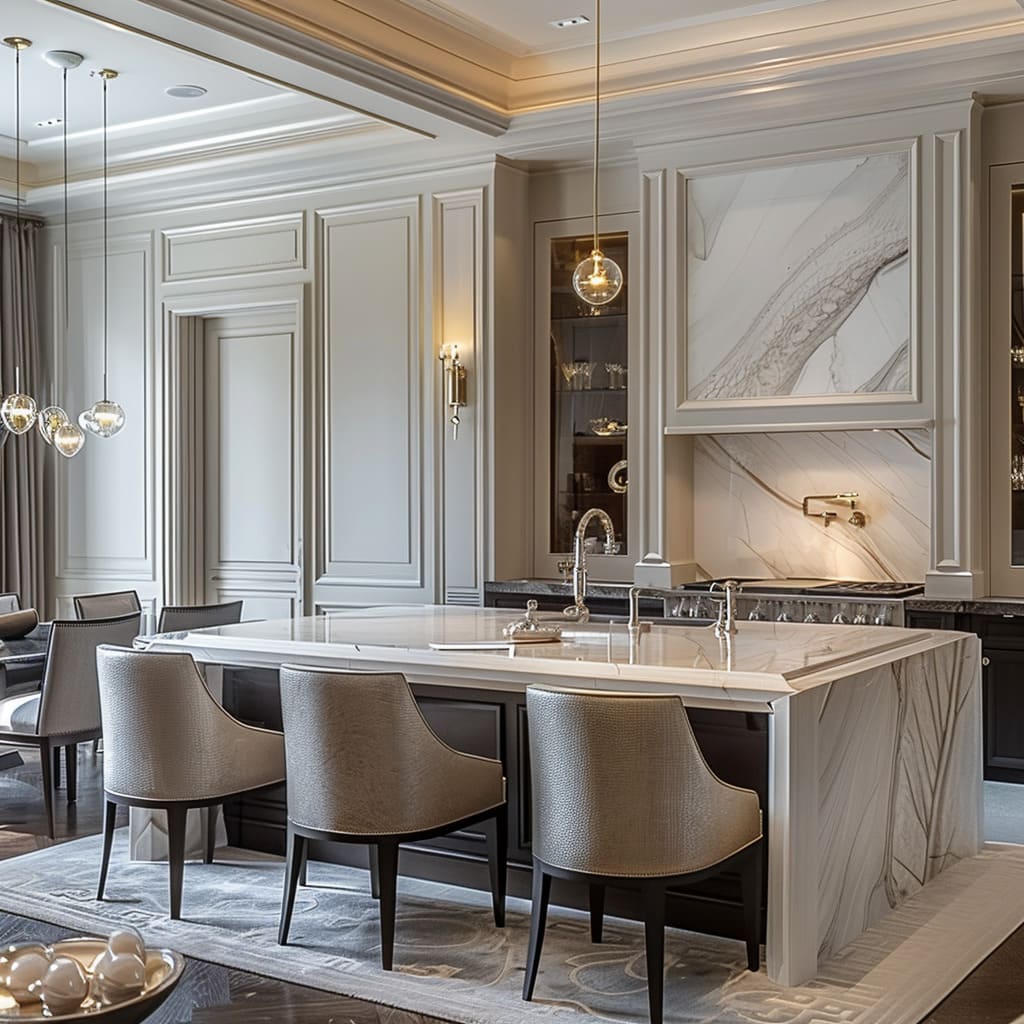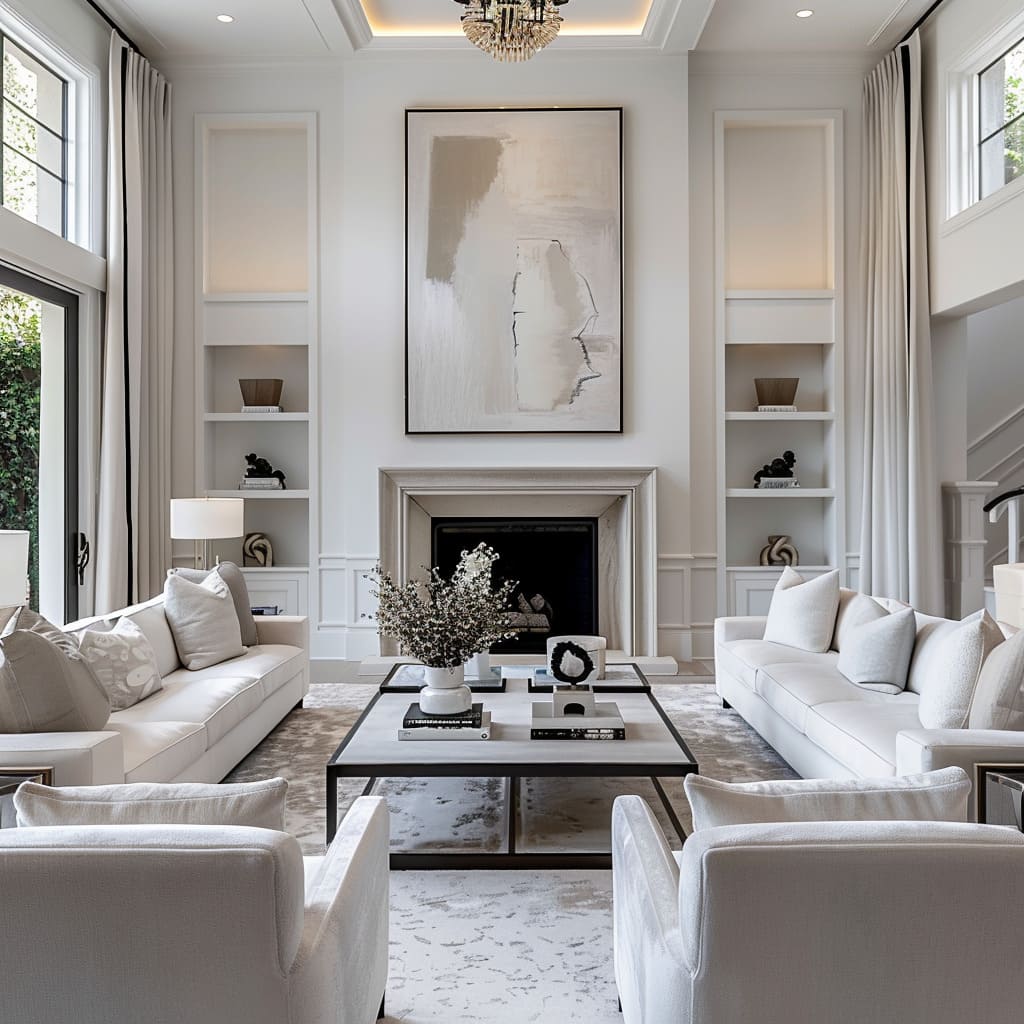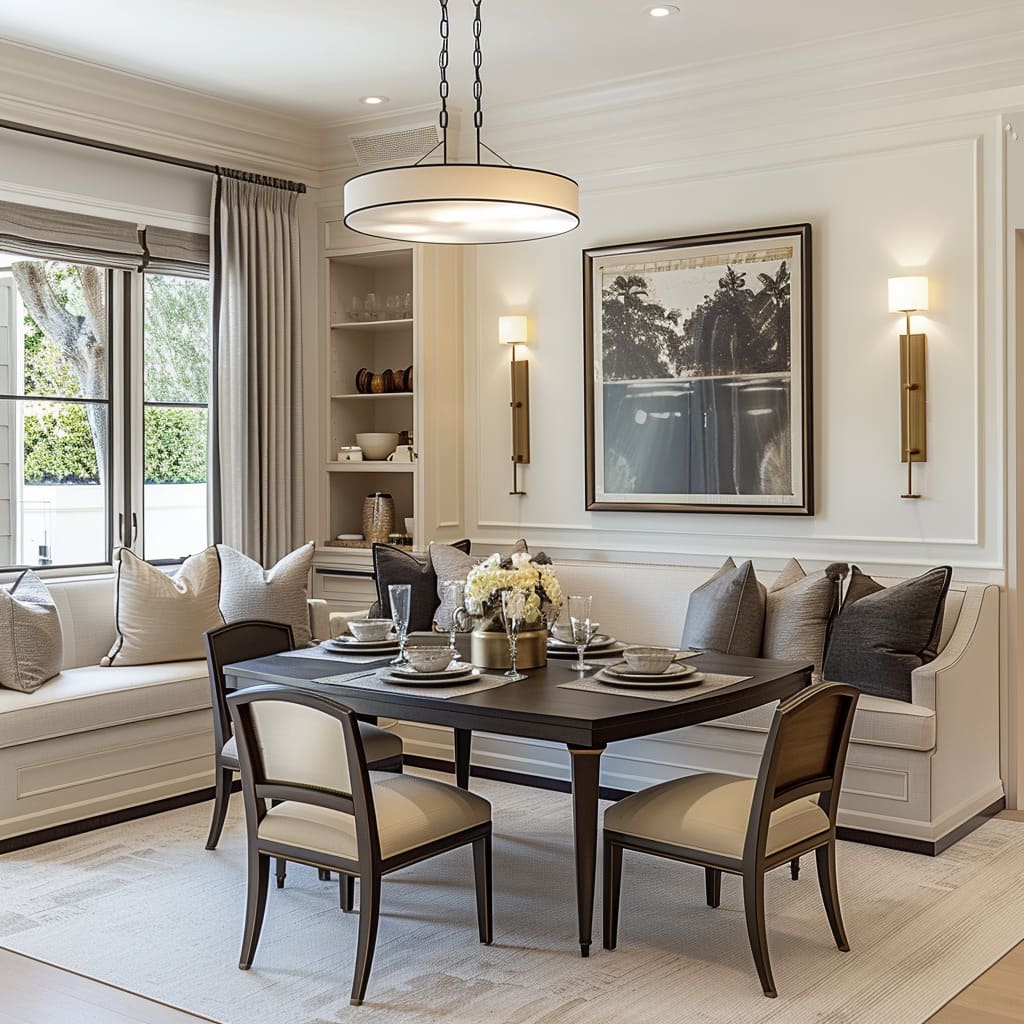In the sphere of interior design, each component is crucial in shaping an environment that’s both visually attractive and practically sound. This examination explores the intricate interactions among diverse design elements that together define our living areas.
From the structural complexities that add depth and character to walls to the careful choice of furniture that blends aesthetics with utility, every aspect is a tribute to the craft of producing environments that align with the residents’ values and way of life. The interplay of light and shadow, the appeal of assorted textures, and the unique details that endow spaces with personality—all merge to form a harmonious array of visual and tactile experiences.
As we peruse these detailed sections, we discover the subtle yet impactful ways design elements unite to craft spaces that are experienced, not just observed.
Architectural and Visual Symphonies
Enriching Spaces with Depth and Reflection
The layering of architectural moldings provides a canvas for shadows and depth, transforming walls into areas of visual interest. Large mirrors augment this effect, reflecting the room’s design and creating a sense of expansiveness.
The strategic use of recessed ceiling lights contributes to a seamless aesthetic, ensuring every line and angle is purposefully illuminated. This section explores how the interplay between architectural features and reflective elements can amplify the sophistication of an interior space.
Use of Architectural Moldings to Add Depth to Walls
The strategic incorporation of architectural moldings on walls brings a three-dimensional character to the interiors, offering a play of shadows and highlights that change with the passing of the day. These moldings, running along the lower and upper sections of walls, frame spaces and add a visual weight that grounds the furnishings.
The precise cuts and alignments of these features showcase skilled craftsmanship, while their repetitive patterns bring rhythm to the spaces, leading the eye along the continuous lines that define each room.
Use of Large Mirrors to Create an Illusion of More Space
Strategically placed large mirrors serve as functional art pieces, reflecting the interior landscape and amplifying the sense of spaciousness within the rooms. These mirrors, often framed in refined metals or wood, add a lustrous quality to the walls they adorn.
They not only bounce natural light around the room but also provide an opportunity for the space to visually double in size, giving a lighter air to the settings they occupy.
Use of Recessed Ceiling Lights to Maintain a Clean Ceiling Line
The integration of recessed lighting fixtures contributes to a polished and uncluttered overhead landscape. These subtle lighting elements are expertly positioned to cast an even glow across the room, highlighting the expansiveness of the space without intruding into the visual field.
Their presence is felt rather than seen, creating an ambiance that shifts focus to the design elements within the room, not the sources of light themselves.
Emphasis on Vertical Lines Through Tall Windows and High Ceilings
The emphasis on verticality is pronounced in the grand scale of tall windows that stretch toward the high ceilings, drawing the gaze upward and lending an air of loftiness to the interiors. These windows, often dressed in soft draperies, work in tandem with the high ceilings to suggest an almost infinite upward extension, while also framing the view to the outside world, inviting the changing landscape into the narrative of the interior.
Incorporation of Classic Crown Molding for a Finished Look
Classic crown molding elegantly transitions the intersection of walls and ceilings, encapsulating the sophistication of the interiors. These ornate yet subtle strips crown the rooms, accentuating their height while bringing a traditional touch that resonates with the furniture below.
Their understated patterns contribute to an overall sense of completeness, acting as the finishing touch in each well-conceived design.
Use of Understated Elegance in the Design of Staircases and Railings
The staircases and railings within these spaces are testimonies to the beauty found in restraint. Free from overly ornate designs, they rely on clean lines and high-quality materials to make a statement.
The railings, sometimes in wrought iron or polished wood, curve gently, providing both safety and a visual guide that draws the eye along their path. The steps themselves, be they carpeted for quietude or left in polished wood for a resonant charm, lead one through the levels of the home with grace.
The Art of Furnishing
Blending Function with Aesthetic Appeal
Furniture selection is pivotal in defining a room’s character. Choices that emphasize form and functionality not only serve the practical demands of living spaces but also act as standalone pieces of visual interest.
Velvet fabrics and high-backed dining chairs cater to the need for comfort while making a statement. This section delves into how furniture with subtle curves and thin legs can impart an airy, inviting atmosphere.
Selection of Furniture with Velvet Fabric to Provide a Sense of Luxury
Furniture upholstered in velvet fabric acts as a hallmark of sophistication within the living spaces, exuding a soft sheen that varies with the angle of light. The plush texture of the fabric invites touch and offers visual warmth, creating an atmosphere of comfort and splendor.
Velvet, as a material choice for sofas and armchairs, imbues the room with a sumptuous feel, while the depth of its color adds a layer of richness to the interior color palette.
Choice of Seating with Subtle Curves to Soften the Look of Rooms
The gentle curvature of seating options serves to break the monotony of straight lines and introduce a soothing aesthetic. Sofas and chairs with rounded edges and smooth contours offer an inviting ambiance, coaxing relaxation and respite.
The soft arcs of these pieces echo the fluidity found in nature, providing an organic counterpoint to the structured architecture of the room. Their presence is a balm to the straight-edged modernity, infusing the space with a welcoming charm.
Selection of Furniture with Thin Legs to Give an Airy Feel to the Space
Furniture standing on slender legs imparts a feeling of lightness and finesse. The delicate framework supporting tables and chairs seems almost to tiptoe on the floor, creating a sense of spaciousness around each item.
This choice in design minimizes visual heft and allows for an unobstructed view of the room, fostering a sense of openness. It is a nod to the aesthetic principle where less is more, and the spaces between objects are as important as the objects themselves.
Choice of Furniture with Both Form and Function in Mind
Furniture that combines aesthetic allure with practicality exemplifies intelligent design, ensuring that beauty and utility are in harmony. Storage units with concealed compartments, sleek shelves that display and organize, and tables that extend or shrink based on need, exemplify this thoughtful approach.
The craftsmanship lies not only in the external appeal but also in the adaptability and ease these furniture pieces offer to everyday living.
Selection of Dining Chairs with High Backs for a Dramatic Effect
Dining chairs with elongated backs stand as sculptural entities around the table, drawing the eye and asserting their presence with an upright poise. The vertical thrust of these chairs not only lends an air of formality to the dining area but also provides substantial support, turning a simple meal into an occasion.
They act as the sentinels of sociability, framing the gatherings of friends and family with a defined edge.
Placement of Occasional Chairs for Additional Seating Without Clutter
Occasional chairs are judiciously positioned to offer extra seating while maintaining the streamlined flow of the space. These chairs are chosen for their compact footprint and their ability to blend with the larger design narrative.
They stand ready to accommodate, yet unobtrusive when not in use, reflecting a considerate aspect of spatial planning. Their presence is an assurance of hospitality, quietly waiting to serve the needs of both the home and its guests.
Light and Space Dynamics
Illumination as a Central Design Element
Chandeliers and floor lamps do more than illuminate; they serve as sculptural centerpieces that dictate the mood of a room. Coupled with the use of glass-top tables, these lighting fixtures create layers of brightness and clarity, influencing not only the space’s illumination but also its perceived size.
Here, we examine how lighting design and transparent surfaces work together to craft an environment that is both functional and visually stimulating.
Incorporation of Statement-Making Chandeliers as a Focal Point
The inclusion of grand chandeliers anchors the rooms, serving not just as sources of light but as central art pieces that command attention. These fixtures, with their intricate designs and radiant glow, draw the eye upward and serve as a luminous centerpiece.
The light cast from their bulbs dances off their ornate details, providing a spectacle of brilliance that enhances the ambiance. Chandeliers chosen for their visual impact resonate with the furnishings below, creating a unified aesthetic that bridges the floor and ceiling.
Utilization of Glass-Top Tables to Provide a Lighter Feel in the Space
Glass-top tables offer an ethereal quality, their transparent surfaces allowing for an uninterrupted view of the room. The reflective nature of the glass magnifies the light, contributing to a brighter, more open feel.
These tables act as subtle showpieces, their presence felt but not imposing, enabling a seamless flow from one area of the room to another. They stand as sleek counterpoints to the more solid furniture pieces, offering balance and contrast within the design scheme.
Incorporation of Floor Lamps for Added Layers of Lighting
Strategically placed floor lamps augment the room’s lighting strategy, adding height and a warm glow to corners that might otherwise be shrouded in soft shadows. These lamps, with their towering forms and sculptural shades, contribute to the creation of intimate nooks within larger spaces.
They offer the flexibility to alter the mood, with their light casting a welcoming pool around seating areas. When illuminated, these lamps not only serve a functional purpose but also act as beacons that guide the flow of the interior landscape.
Textural Harmony and Comfort
Creating a Tapestry of Sensory Experiences
From the feel of an area rug beneath one’s feet to the comfort of throw pillows and the delicate textures of fabric, interiors become a tactile experience. Matte finishes on surfaces and the soft touch of ceramic or porcelain accessories add to the subtlety of the environment, inviting touch and exploration.
This section explores the importance of texture in creating a space that is as comfortable as it is visually engaging.
Use of Large Area Rugs to Define Spaces and Add Comfort Underfoot
The strategic placement of large area rugs delineates different functional areas within an open floor plan, creating cozy islands amidst the hardwood or tile flooring. These rugs, often in subdued hues or intricate patterns, add a tactile layer to the room, inviting bare feet to sink into their plush weaves.
Not only do they soften the acoustics by dampening the sounds of footsteps and movement, but they also serve as a visual anchor for the furniture that rests upon them, uniting various design elements into a cohesive whole.
Use of Throw Pillows for Added Comfort and a Pop of Color
An assortment of throw pillows provides a simple yet effective means to infuse a living space with both comfort and vibrant hues. Arranged on sofas and chairs, these pillows can be easily rearranged to suit the mood or occasion, allowing for a quick refresh of the room’s color scheme.
The choice of fabrics for these pillows ranges from smooth silks to textured linens, each contributing to a diverse tactile experience. Beyond their aesthetic value, these soft furnishings offer a welcoming softness, inviting one to relax and linger.
Selection of Matte Finishes on Surfaces to Reduce Glare and Enhance the Soft Feel of the Space
Opting for matte finishes on various surfaces within the room achieves a subtle sophistication that eschews the starkness of high shine. This choice is particularly evident on countertops, cabinetry, and large appliances, where a matte surface contributes to a calm, consistent look.
Such finishes absorb rather than reflect light, contributing to an ambiance of serenity and focus. This absence of glare not only enhances the visual comfort but also highlights the quality and craftsmanship of the materials.
Incorporation of Delicate Fabric Textures to Add Interest Without Overpowering
The careful selection of delicate fabric textures throughout the space brings an understated complexity to the interiors. These textures, found in drapery, upholstery, and accent pieces, interact subtly with the lighting and surrounding elements to give a layered richness to the aesthetic.
From the fine weave of a throw blanket to the intricate stitching on a decorative pillow, these textures invite close inspection and reward the sense of touch with their fine detailing.
Use of Varied Pillow Shapes for an Informal Touch
The introduction of various pillow shapes throughout the living areas contributes to a laid-back and inviting atmosphere. Beyond the standard squares, elongated lumbar pillows, round bolsters, and even whimsically shaped cushions add an element of playfulness.
These varied forms not only create visual interest but also cater to different comfort needs, whether for supporting the back, cradling the head, or hugging close. This informal approach to decor suggests a space that is lived in and loved, where each piece has been chosen for its contribution to the overall feel of home.
Decorative Accents and Personal Touches
Personalizing Spaces with Thoughtful Details
The thoughtful placement of books, candles, and fresh flowers infuses an interior with personality and life. Sconces and side tables offer both utility and an opportunity for personal expression, while subtle recessed wall niches present a stage for treasured items.
This section looks at the small, yet significant elements that make a home feel truly inhabited and cherished.
Placement of Books as Decorative Yet Informative Elements
Books, thoughtfully arranged, serve not just as bastions of knowledge but also as objects of visual appeal. Whether lining a shelf or stacked on a coffee table, they suggest an intellectual richness and a lived-in quality.
The spines of these books often introduce a variety of colors and textures to the room, and their titles offer insight into the homeowner’s interests, inviting conversation and contemplation.
They stand not only as solitary units of information but also as components in a larger mosaic of personal expression.
Use of Ceramic or Porcelain Accessories for a Subtle Touch of Refinement
The presence of ceramic or porcelain accessories brings a delicate artistry to the space. These items, often handcrafted and boasting intricate patterns or glazes, function as visual softeners among the more substantial furniture pieces.
Vases, bowls, or figurines in these materials convey an appreciation for fine arts and craftsmanship, their glossy finishes catching the light and providing points of interest within the room’s landscape.
Inclusion of Brass or Gold-Finished Hardware to Add a Touch of Warmth
Accents of brass or gold-finished hardware gleam subtly throughout the space, imparting a sense of warmth and understated opulence. Whether on door handles, drawer pulls, or frames, these metallic touches draw the eye with their reflective quality, breaking up the monotony of the room’s color palette.
Beyond mere functionality, these details work in concert with other design elements to infuse a subtle radiance into the atmosphere.
Placement of Side Tables as Both Functional and Decorative Elements
Side tables perform a dual role, offering convenience and enhancing the room’s decor. Positioned next to chairs and sofas, they hold lamps, drinks, or reading material, serving the room’s occupants with accessibility.
The design of these tables, from classic to contemporary, complements the surrounding furnishings and contributes to the narrative of the room, often echoing the shapes and materials found elsewhere in the decor.
Placement of Sconces for Soft, Ambient Lighting
Wall-mounted sconces provide layers of soft, ambient light that complements the overhead lighting scheme. Their glow casts a gentle illumination that can highlight artworks or architectural features, and their designs often mirror the stylistic themes of the space.
These lighting elements play a key role in setting the mood of the room, offering a soothing alternative to the brighter, more direct light sources.
Use of Subtle Recessed Wall Niches for Displaying Cherished Items
Recessed wall niches offer discreet alcoves for the display of cherished items, allowing personal treasures to be framed within the architecture itself. These niches, with their contained lighting, can spotlight a select piece of sculpture, a family heirloom, or any object of personal significance.
They act as quiet celebrations of individuality, turning personal items into focal points without the need for additional shelving.
Placement of Candles and Diffusers to Engage the Senses
Candles and diffusers, carefully positioned throughout the room, activate the senses beyond sight and touch. The flicker of candlelight provides a primal comfort, while the scents released by both candles and diffusers can evoke memories, calm the spirit, or energize the mind.
They play an important role in creating a multisensory experience that transforms the space into a sanctuary.
Placement of Fresh Flowers to Bring a Bit of Nature Inside and Add a Fragrance to the Room
The introduction of fresh flowers breathes life into the interior, their natural beauty and fragrance acting as a bridge to the outdoors. These botanical elements, whether in a grand arrangement or a simple bouquet, add an organic, dynamic touch to the room.
Their colors can complement or contrast with the decor, and their transient nature serves as a reminder of the passing of time, inviting residents and guests alike to pause and appreciate the present moment.
Cohesion and Flow
Seamless Integration of Design Elements
Monochromatic color schemes and the strategic arrangement of seating facilitate a seamless flow throughout a space, encouraging movement and interaction. The inclusion of brass or gold-finished hardware and the utilization of understated window treatments exemplify the nuanced approach to design that ties a room together.
In this section, we analyze how cohesion is achieved through the careful selection and placement of each design component.
Arrangement of Seating to Encourage Conversation
The deliberate arrangement of seating fosters an inviting atmosphere for dialogue and togetherness. Sofas and chairs are positioned to face each other, encouraging eye contact and interaction among those seated.
This configuration promotes an easy exchange of ideas and comfortable socialization, transforming living areas into hubs of communal activity. The furniture’s placement is designed not only for aesthetic symmetry but also for its sociability, ensuring that each seat feels integrated into the conversational circle.
Utilization of Monochromatic Color Schemes to Create a Calm Atmosphere
The application of monochromatic color schemes provides a visual continuity that soothes the senses and establishes tranquility. Various shades and tints of a single hue are employed to lend depth and dimension without the visual interruption of contrasting colors.
This subtle gradient effect from walls to furnishings maintains a serene and cohesive ambiance, where the focus is on the quality of light and space rather than the distraction of multiple colors.
Use of Understated Window Treatments to Complement the Interior Architecture
Window treatments are chosen with a thoughtful simplicity to blend seamlessly with the room’s design. Curtains in soft, flowing fabrics frame the windows without overshadowing the architectural elements.
These treatments filter light to cast a soft glow, enhancing the serene quality of the spaces. Their colors and materials are selected to harmonize with the walls and furniture, contributing to a unified look that respects the lines and forms of the room’s architecture.
Artistic Expression
Curating a Narrative through Art and Color
Abstract art pieces provide a contemporary counterpoint to more traditional elements, suggesting a narrative that is unique to each space. Muted wall art allows for visual breathing room, ensuring that each piece speaks without shouting.
Here, we look at how art and color can be curated to express the homeowner’s personal style and to create a space that tells a story.
Incorporation of Large-Scale Artwork to Create Visual Interest
Large-scale artworks serve as captivating focal points within the room, drawing the eye and stimulating interest. These pieces, whether paintings, tapestries, or large sculptural installations, imbue the space with a dynamic energy and a personal touch that reflects the homeowner’s taste.
Positioned strategically, they balance the room’s proportions, often anchoring a large wall or acting as a counterpoint to a significant furniture arrangement. The scale of such artwork adds a dramatic flair, inviting viewers to pause and engage with the piece, sparking imagination and conversation.
Use of Muted Wall Art to Complement, Not Overwhelm, the Space
The careful selection of muted wall art ensures that the pieces enhance rather than dominate the room’s design. These artworks, characterized by their subdued colors and gentle compositions, meld harmoniously with the surrounding decor, adding layers of texture and interest without causing visual clutter.
Their presence is felt as an integral part of the overall aesthetic, contributing to the room’s ambiance without competing for attention. This approach allows the art to be appreciated as a subtle complement, enriching the environment with a sophisticated understatement.
Choice of Abstract Art to Introduce a Contemporary Edge
Abstract art introduces an element of the unexpected, with its non-representational forms and vibrant interplay of colors and shapes sparking curiosity and reflection. The choice to include such pieces signifies a modern sensibility, embracing art that invites interpretation and personal connection.
These artworks act as a bridge between traditional and contemporary styles, lending a fresh, avant-garde perspective to the space. Their presence can energize a room, providing a lively contrast to more classic design elements and fostering a space that feels current and dynamic.
Incorporation of Classic Design Elements with a Modern Twist
Integrating classic design elements with a modern twist achieves a timelessness that honors the past while embracing the present. This approach might manifest in traditional motifs reimagined in contemporary materials or classic silhouettes updated with modern finishes.
Such fusion creates a layered interior that resonates with depth and history while maintaining a foot firmly in the now. It’s a testament to the room’s design narrative, one that values evolution in style while respecting historical roots, offering a space that is both familiar and refreshingly new.
Wrapping up this detailed examination of interior design’s complex layers, we gain a heightened respect for the numerous details that come together to establish serene living environments. Each part of this analysis emphasizes the importance of deliberate design, showing how structural nuances, furniture choices, lighting arrangements, textural mixes, and ornamental accents collectively tell the tale of a space.
It’s a story that goes beyond simple looks, reaching into the domain of personal expression and tangible living.
Reflecting on the various ways these design elements interact, it’s clear that interior design’s core is its capacity to provoke feelings, nurture connections, and improve our everyday experiences. Viewing it through this perspective, we realize that a space’s true allure isn’t merely in its visual charm but in its ability to connect with its occupants, providing a setting that’s not just striking to view but also deeply aligned with their identity and comfort.

